Datebook: A performance art fest, a film composed from still images, an artist paints his father’s gun
The winter arts season is off and running with a performance art festival, a photographer’s debut film, and still-life paintings of weapons. Here are the exhibitions and events to be checking out in the coming days:
Pacific Standard Time Festival: Live Art LA/LA, in locations around Los Angeles. The performance part of PST has landed! More than 200 Latin American and U.S. Latino artists will be staging events at more than 25 locations around the city. This will involve wild Mexican cabaret (Astrid Hadad at the Mayan), a floating concert on a lake (Carmina Escobar in Echo Park), a revisionist look at Peruvian history (Grupo Cultural Yuyachkani at REDCAT), and a three-part performance that touches on water, bridges and the layered history of downtown Los Angeles (Rafa Esparaza at the Museum of Contemporary Art in Little Tokyo). Plus, there are countless other gigs for every schedule and taste. Kicks off today with performances by Hadad, the Brazilian collective Opavivará!, Chilean artist Sylvia Palacios Whitman and the Mexico City collective Lagartijas Tiradas al Sol, in locations around the city. Through Jan. 21. redcat.org.
Rachel Feinstein, “Secrets” and “Man Ray’s LA,” at Gagosian Gallery. Gago is unveiling a couple of new shows for the winter season. The first is by New York artist Rachel Feinstein, known for wild sculpture that draws from the excesses of the baroque. Her show will include a series of human figures rendered slightly larger than life, as well as paintings and wallpaper. In a separate gallery will be a show of works created by the surrealist Man Ray between 1940 and 1951 during his time in Los Angeles — a period when he was moving away from commercial photography to focus on fine art. Opens today at 6 p.m. and runs through Feb. 17. 456 N. Camden Dr., Beverly Hills, gagosian.com.
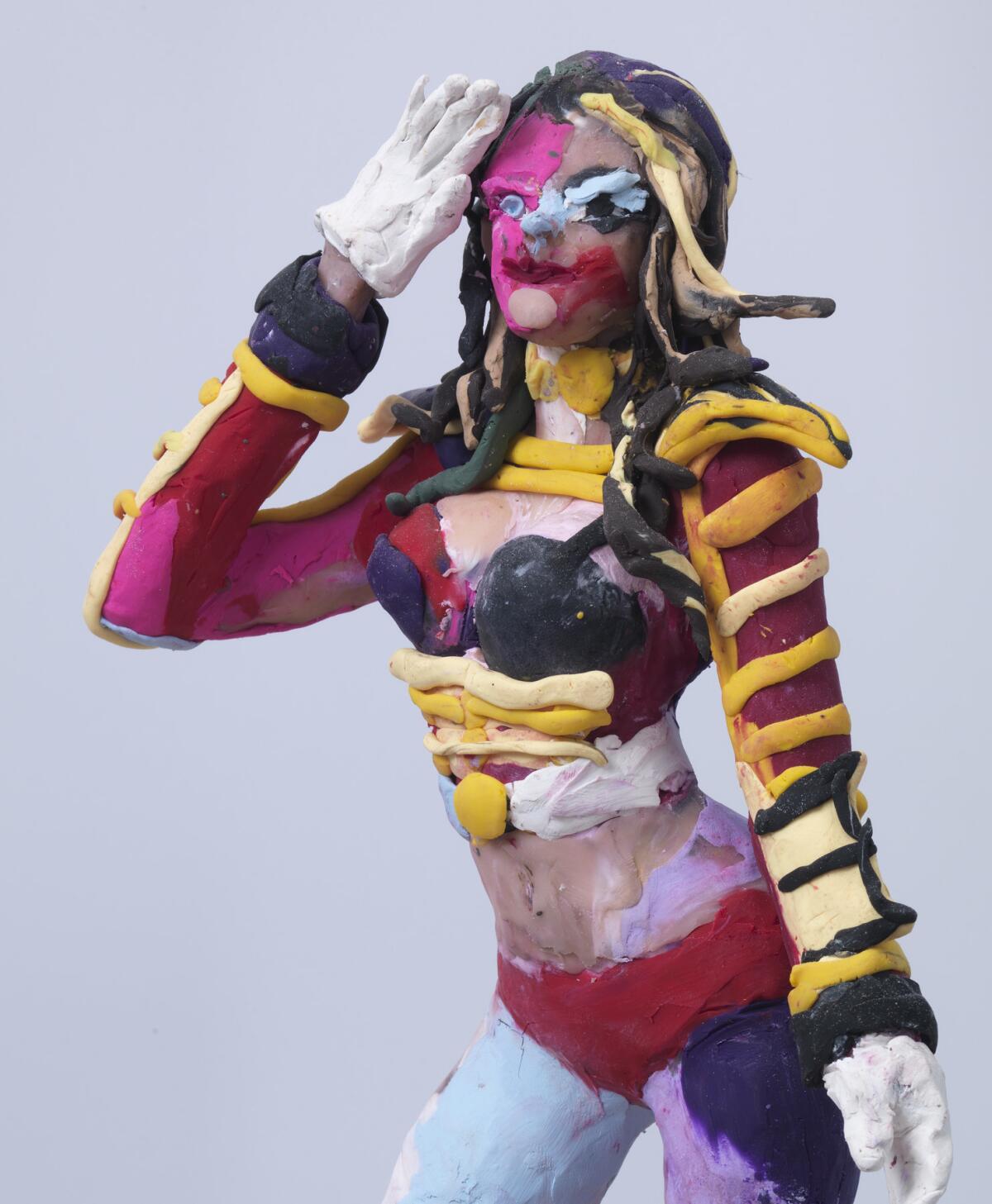
Catherine Opie, “The Modernist,” at Regen Projects. In her ninth solo show at the gallery, the Los Angeles photographer is debuting her first film, “The Modernist,” which presents a story of time travel and apocalypse in a dystopic L.A. Inspired by the work of Chris Marker, who directed the radical 1962 film “La Jetée,” which consisted of a cinematic sequence of still images, the 22-minute film is composed of more than 800 black and stars Stosh, a friend who has appeared in many of her photographs. Opens Friday at 6 p.m. 6750 Santa Monica Blvd., Hollywood, regenprojects.com.
Judith Linhares, “The Way She Goes to Town,” at Various Small Fires. The Los Angeles artist is known for her paintings of “unabashed” women — featuring buoyant figures working, dancing and in repose, all rendered in broad brushstrokes and acid colors. Opens Friday at 6 p.m. and runs through Feb. 24. 812 N. Highland Ave., Hollywood, vsf.la.
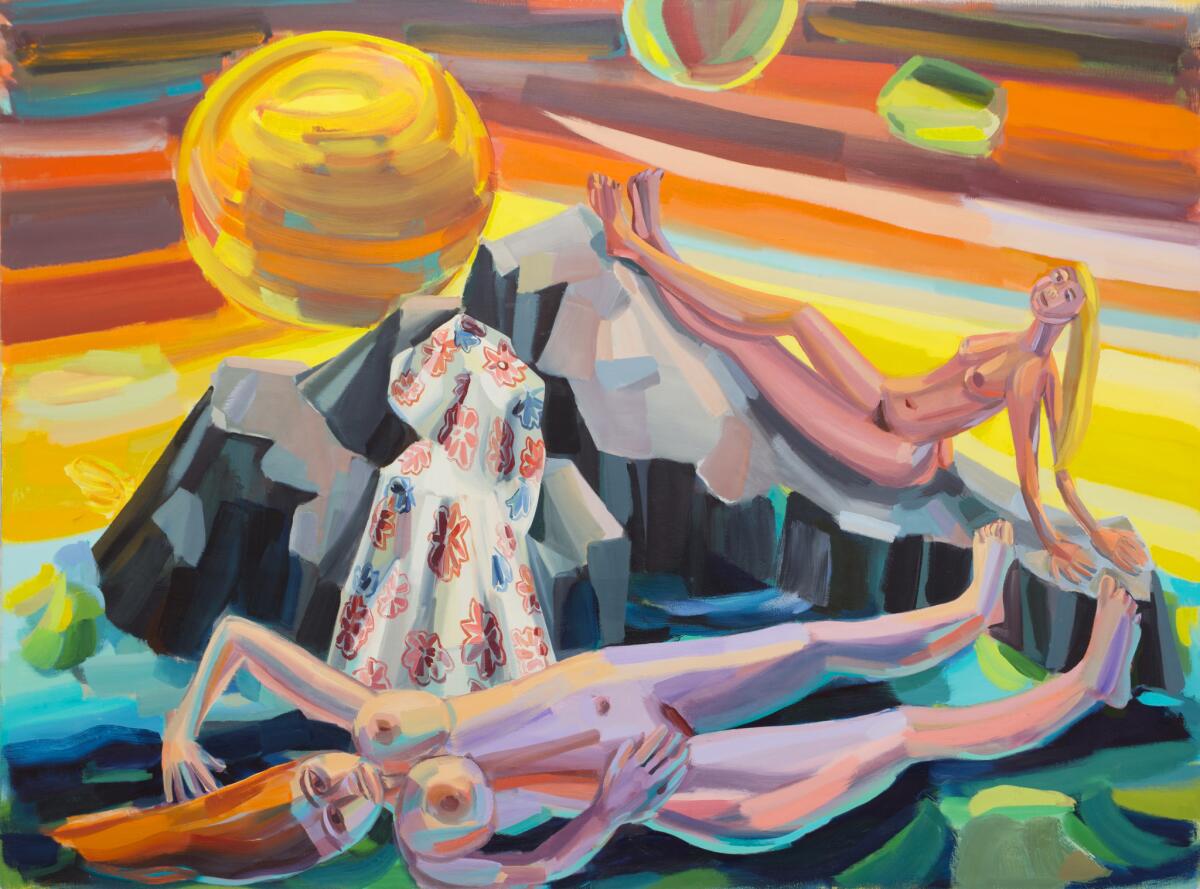
Alejandro Jodorowsky and Pascale Montandon-Jodorowsky, “pascALEjandro,” at Blum & Poe. This is the first major U.S. exhibition of work by the creative pair: he, the renowned film director; she, a long-time painter. The show will brings together their whimsical, often mystical collaborative illustrations, all produced over the last couple of years. Opens Sunday and runs through March 3. 2727 S. La Cienega Blvd., Culver City, blumandpoe.com.
Xylor Jane, “Magic Square for Earthlings,” at Parrasch Heijnen. The Long Beach-born painter is known for producing gridded, mathematics-inspired works that also have a practically hallucinatory texture. This is created by layering ink and oil atop each other, all of it on such a small scale that she has to wear a magnifying visor when she paints. Opens Saturday at 6 p.m. and runs through Feb. 17. 1326 S. Boyle Ave., Boyle Heights, Los Angeles, parraschheijnen.com.
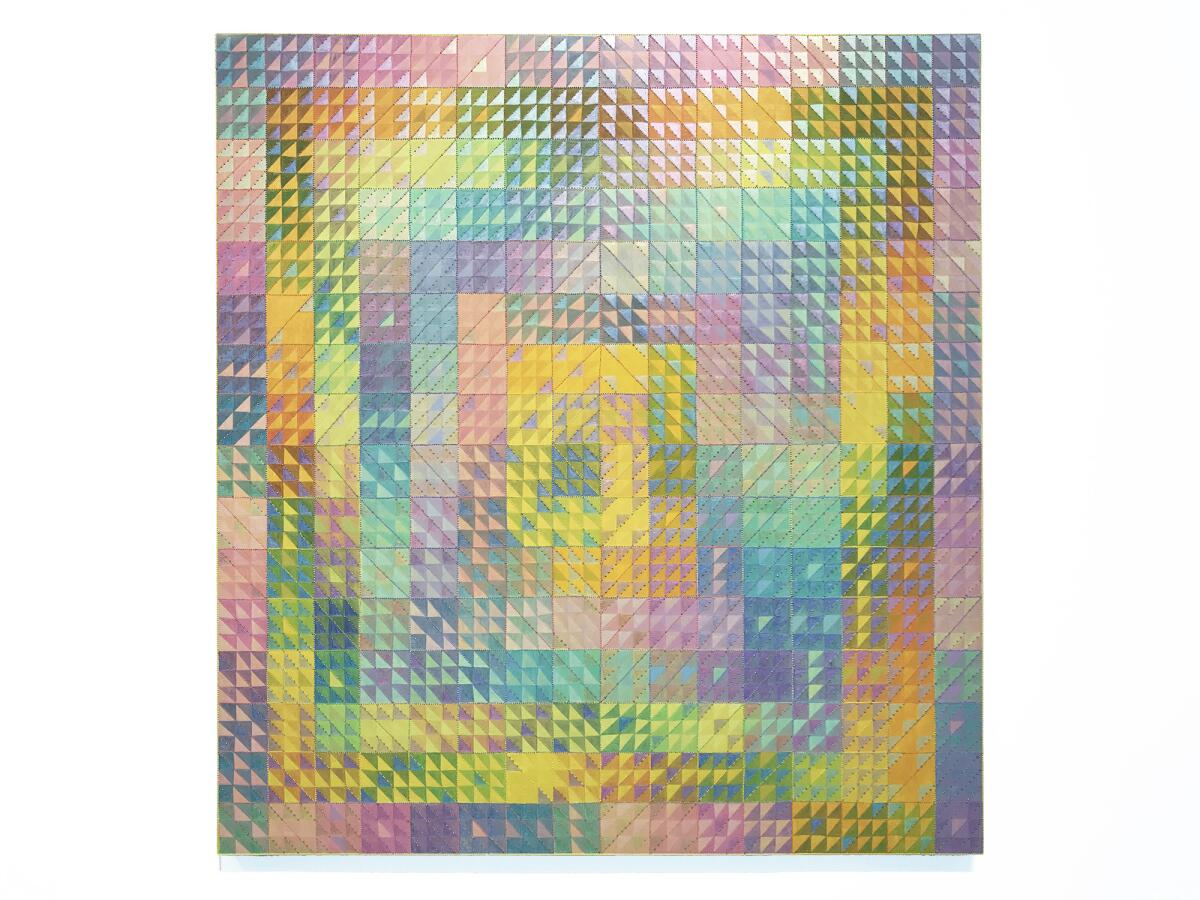
Galeria Perdida, “Grief Will Be My Mirror,” at Mandujano Cell. The Mexican collective has created a sculptural installation that draws a connection between Goth subculture and the poet and filmmaker Piero Paolo Pasolini. Should be good and weird. Opens Saturday at 9 p.m. and runs through Feb. 24. 171 N. La Brea Ave., Inglewood, mandujano-cell.com.
Alyse Emdur, “Skunks and Flowers,” at Odd Ark LA. The Los Angeles artist takes bright nature scenes inspired by the graphic work of Vera Neumann and inserts into their joyous midst roving skunks that serve as a stand-in for femininity’s darker, more mysterious side. Opens Saturday at 4p.m. and runs through March 4. 7101 Figueroa St., Unit E, Eagle Rock, oddarkla.com.
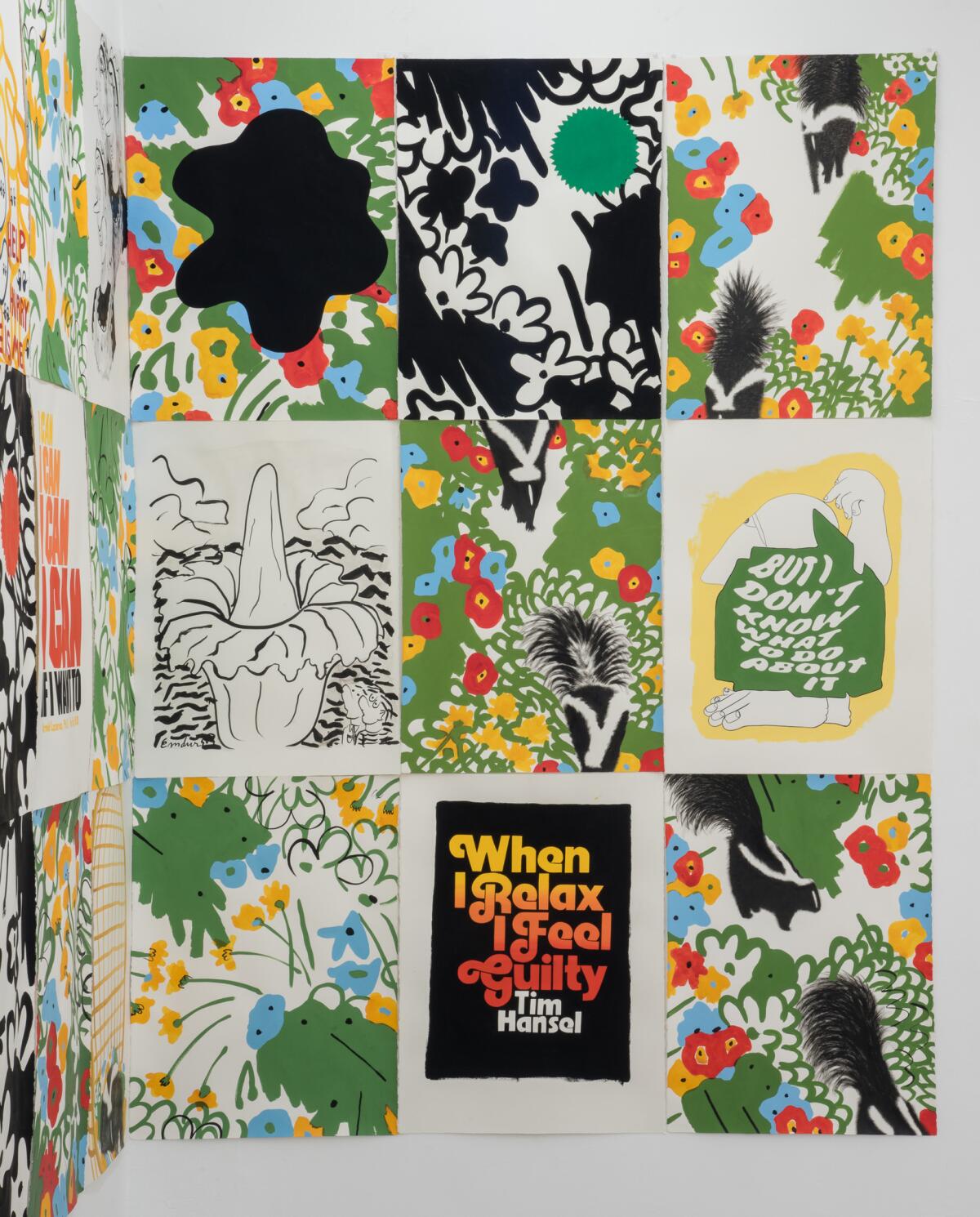
Matsumi Kanemitsu, “East/West,” at Louis Stern Fine Arts. Kanemitsu’s storied life took him between Japan, the U.S. and Europe — and included everything from a stint in a World War II internment camp to a period spent studying with Fernand Leger. The show brings together a series of works produced by this second-generation abstract expressionist between 1958 and 1975, including canvases saturated with sensuous color and defined by fluid brushstrokes. Through Feb. 17. 9002 Melrose Ave., West Hollywood, louissternfinearts.com.
Marty Schnapf, “Fissures in the Fold,” and Maria Lynch, “Black Over White,” at Wilding Cran Gallery. The Arts District space is kicking off the winter season with a pair of new shows. This includes an exhibition of new paintings by Schnapf, featuring his surreal and contorted figures inhabiting and slipping into landscapes of color and shape, and Lynch’s new graphite-on-paper drawings, which often serve as starting points for bright paintings. Opens Saturday at 5 p.m. and runs through March 10. 939 S. Santa Fe Ave., downtown Los Angeles, wildingcran.com.
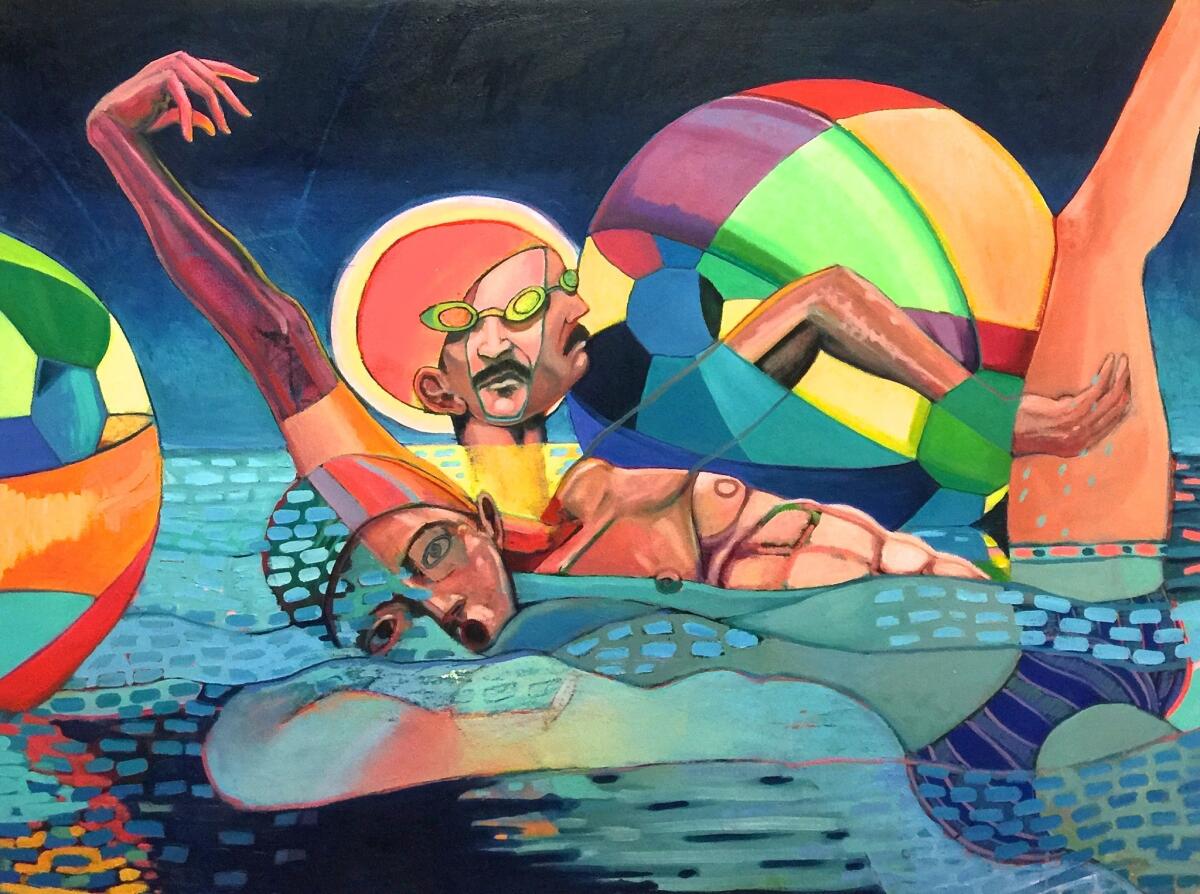
Salomon Huerta, “Still Life Painting,” at There There. A series of still lifes depict items of food and a gun — the one that belonged to his father. They are meditative works that are also charged with a threat of violence. Opens Saturday at 6 p.m. and runs through Feb. 10. 4859 Fountain Ave., East Hollywood, there-there.co.
Pouya Afshar, “En Masse,” at the Space. The Iranian American artist creates paintings, drawings and animations that dwell on Persian and Muslim Shiite mourning rituals in modern ways. Opens Sunday at 4 p.m. and runs through Jan. 28. 924 S. San Pedro St., downtown Los Angeles, advocartsy.com.
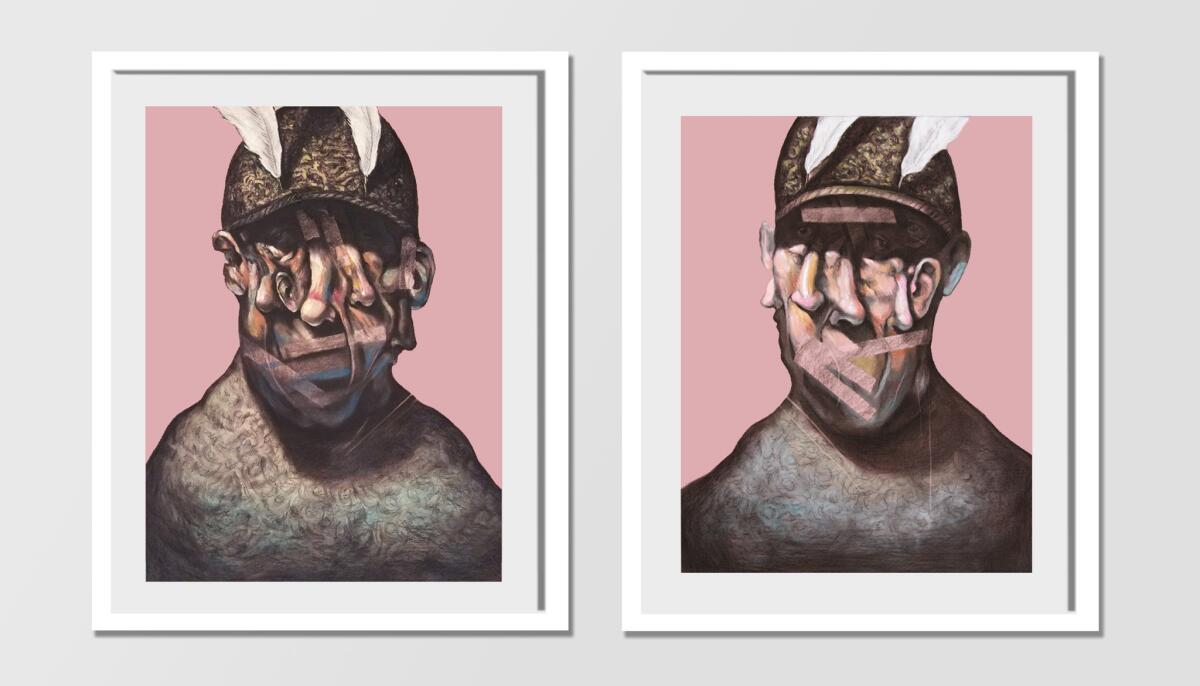
LAST CHANCE
“Fantasies and Fallacies,” at the Consulate General of Mexico. Independent curator Karla Aguiñiga has put together an exhibition that brings together the work of 35 Mexican and Latino artists — all under the age of 35 — whose work explores issues of identity, mythology and folklore, among other topics. Affiliated with PST: LA/LA, the show includes pieces by artists such as Artemisa Clark, Teresita de la Torre, Cognate Collective and Dulce Soledad. Through Friday. 2401 W. 6th St., Westlake, Los Angeles, pacificstandardtime.org.
“One Year: The Art of Politics in Los Angeles,” at the Brand Library & Art Center. A year after the presidential election that put Trump into office, this group show has gathered the work of 20 L.A.-based artists whose work engages topics such as immigration, race, gender and environmental issues. Participating artists include Kim Abeles, HK Zamani, Ben Sakoguchi, Mark Steven Greenfield and Star Montana, among others. Through Friday. 1601 W. Mountain St., Glendale, glendaleca.gov.
Marisa Takal, “Beyond Oy Too Scared to Ha-Ha,” at Night Gallery. The L.A.-based painter creates canvases that blend figuration and abstraction for compositions that bring together quivering bits of color with familiar objects and symbols — all bound by plenty of wry humor. Through Friday. 2276 E. 16th St., downtown Los Angeles, nightgallery.ca.
“Engender,” at Kohn Gallery. A group show looks at the ways in which 17 contemporary artists are approaching the topic of gender through painting, picking apart the idea of the binary in ways that are figurative, expressive and abstract. This includes works by figures such as Hernan Bas, Tschabalala Self, Mequitta Ahuja and Nathaniel Mary Quinn. Through Saturday. 1227 N. Highland Ave., Hollywood, kohngallery.com.
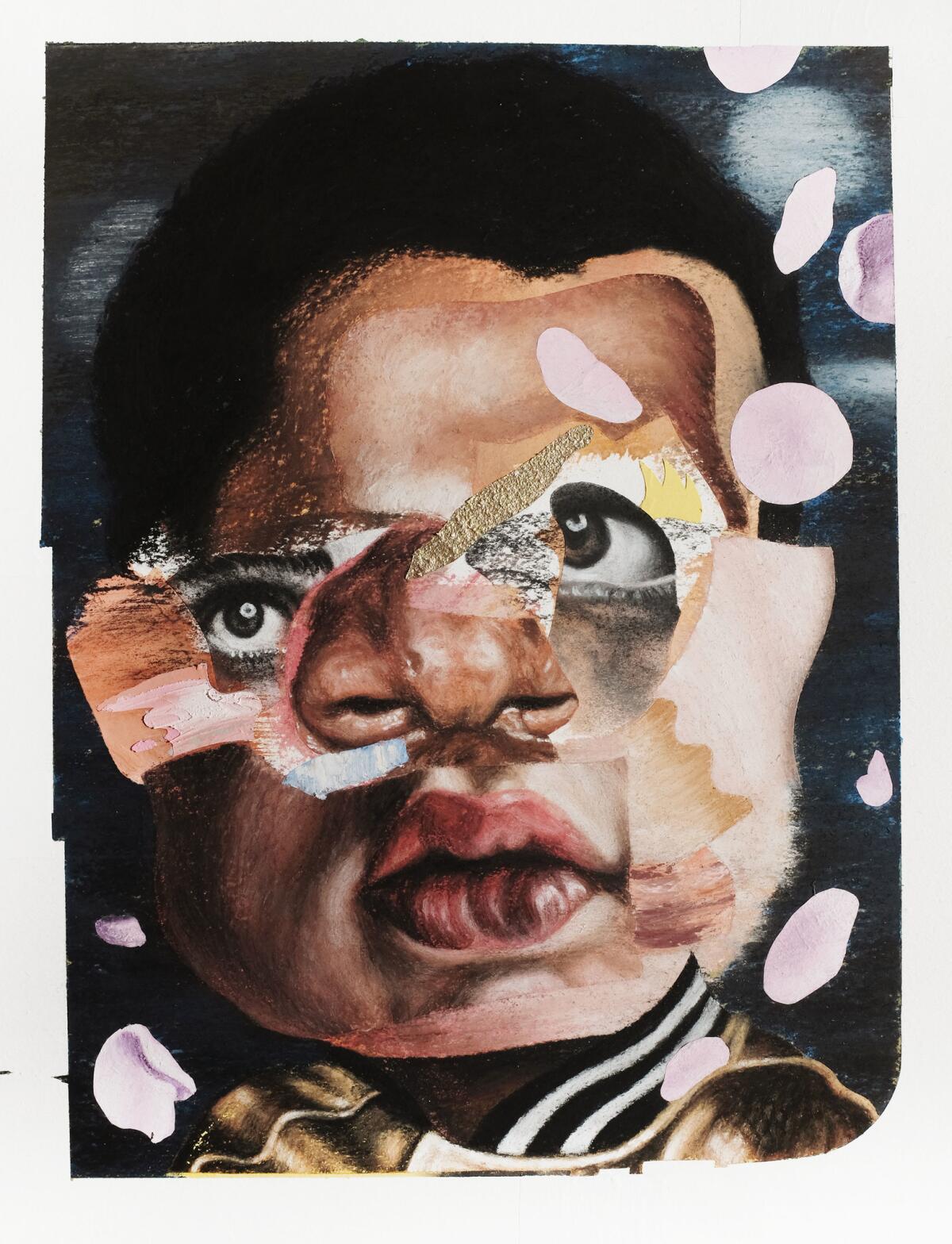
Roberto Gutierrez, “Paris / New York / Los Angeles,” at Plaza de la Raza. This exhibition brings together the work of the East Los Angeles painter (born and raised), whose bright canvases depict city and landscape. These include paintings that capture East L.A., but also other sites he has spent time in, such as Paris and New York. Through Saturday. 3540 N. Mission Road, Lincoln Heights, Los Angeles, plazadelaraza.org.
“Caroline Larsen: Poolside,” and “Dominic Terlizzi: A Spirit Knows,” at Craig Krull Gallery. Larsen’s “Poolside” paintings — which with their deep, playful layers of paint explore the subject of the swimming pool in the Southern California landscape in ways that hearken to textiles and embroidery. Terlizzi’s all-white works, in the meantime, turn thick forms of paint into elements that feel constructed and collaged. Through Saturday. 2525 Michigan Ave., Building B-3, Santa Monica, craigkrullgallery.com.
Harmony Hammond, “Recent Paintings,” and Shana Lutker, “a.k.a. Public Opinion,” at Susanne Vielmetter Los Angeles Projects. Hammond’s first solo exhibition in Los Angeles, brings together the near-monochrome Chenille paintings for which she is known: deeply textured works that feature layers of burlap, paint and other elements that appear to come apart at the seams. In a separate show, the L.A.-based Lutker is showing work from the fifth chapter of her ongoing series examining the historic fights of the surrealists. (This one focuses on the night in 1935 when André Breton repeatedly slapped the Russian critic Ilya Ehrenburg with a green glove. So much drama!) Through Saturday. 6006 Washington Blvd., Culver City, vielmetter.com.
“We Wanted a Revolution: Black Radical Women. 1965-85,” at the California African American Museum. A group show focuses on work by African American female artists and seeks to expand the conversation about social justice and feminism to include the many black artists who were also engaged in struggles for equality — both gender and racial. The exhibition includes work by key U.S. artists, including Betye Saar, Lorna Simpson, Maren Hassinger, Alison Saar and Lorraine O’Grady, among countless others. The show will come to a close with a special symposium that will feature presentations by Alison Saar and Faith Ringgold and a performance by Maren Hassinger. Through Sunday. 600 Exposition Drive, Exposition Park, Los Angeles, caamorg.
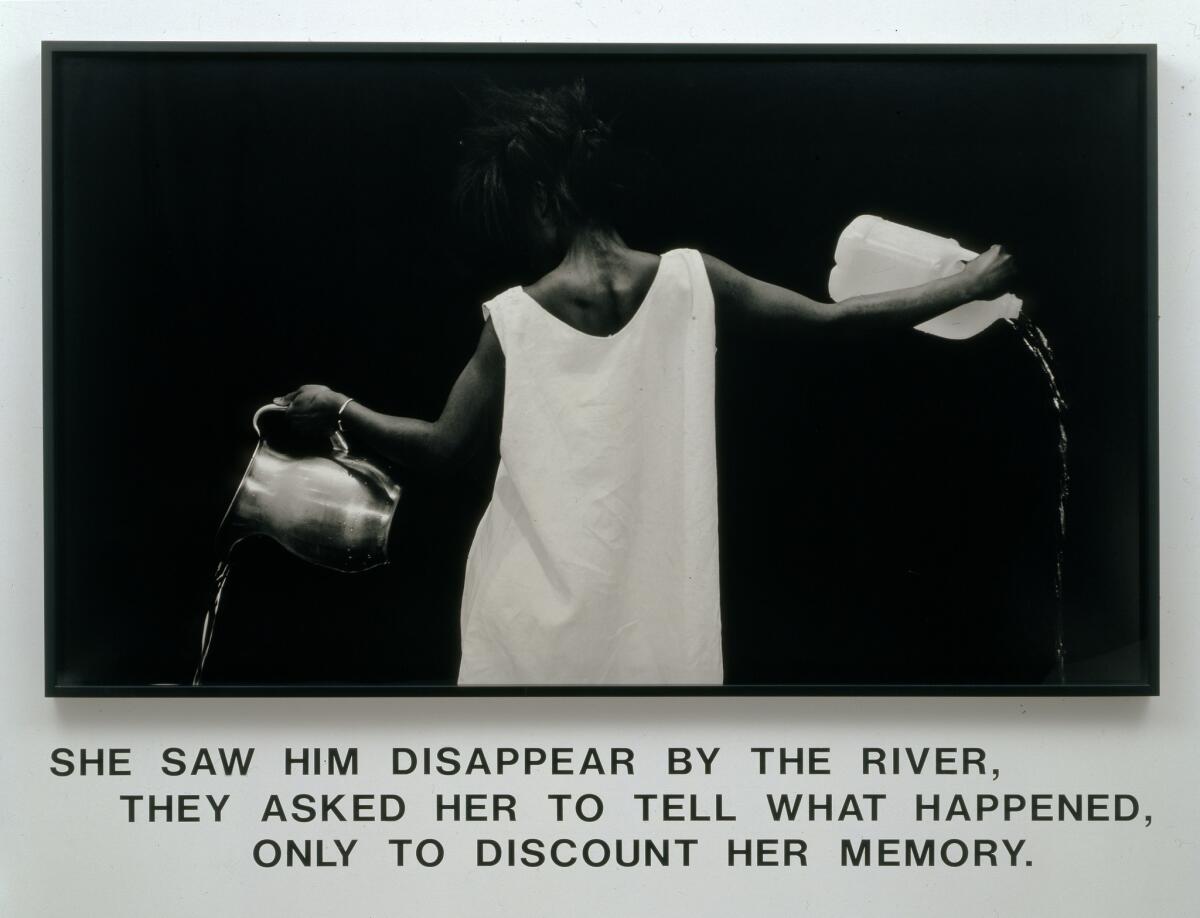
“How to Read El Pato Pascual: Disney’s Latin America and Latin America’s Disney,” at the MAK Center and the Luckman Fine Arts Center. Organized by curator Jesse Lerner and artist Ruben Ortiz-Torres, this intriguing exhibition looks at the ways in which Disney was influenced by Latin America and how Latin America has taken Disney cartoon characters and co-opted them for its own purposes. It’s a comprehensive look at how culture is reflected back and forth between the U.S. and Latin America — one based on imagery crafted in Disney’s studio right in Los Angeles. For students of history, the related catalog is a must. Through Sunday. MAK Center, 835 N. Kings Road, West Hollywood, makcenter.org. Luckman Fine Arts Center, 5151 State University Drive, Los Angeles, luckmanarts.org.
“Giovanni Bellini: Landscapes of Faith in Renaissance Venice,” at the Getty Museum. Bellini was one of the most influential painters to emerge out of the European Renaissance. This exhibition looks at the ways in which he employed landscapes in his religious paintings, producing naturalistic backdrops that added an unprecedented element of ethereal beauty and reality to the art of the era. Through Jan. 14. 1200 Getty Center Drive, Brentwood, Los Angeles, getty.edu.
“Kinesthesia: Latin American Kinetic Art, 1954-1969,” by Palm Springs Art Museum. Paris has long been thought of as the heart of the kinetic art movement — art that plays with light, form and shape to create a sensory experience. But this exhibition, organized by guest curator Dan Cameron as part of the Pacific Standard Time: Los Angeles / Latin America series, looks at the contributions to the movement by important South American figures. This includes innovative work by key figures as Carlos Cruz-Diez, Julio Le Parc and Martha Boto. Definitely worth a weekend in the desert. Through Monday. 101 N. Museum Dr., Palm Springs, psmuseum.org.
Rebecca Chernow, “#superbloom,” at the Grand Central Art Center. Using items that are often disposed of around Santa Ana, the artist has created her own tribute — in waste — of the wild blooms that happened in California poppy fields last spring. The piece explores what was left off the Instagram displays of all those desert blooms — the traffic and trash that accumulated as a result — while providing further opportunities for social media photography. Through Wednesday. 125 N. Broadway, Santa Ana, grandcentralartcenter.com.
ONGOING
Consuelo Jimenez Underwood, “Mano-Made: New Expression by Latin Artists,” at Craft in America Center. As part of a series of exhibitions focusing on the work of three artists, the Center now turns its attention to Jimenez Underwood, who is known for large-scale map-style depictions of borders employing materials such as fiber and found objects, including wire and nails. For the show she is creating a borderline that will envelop the center in collaboration with high school students. Through Jan. 20. 8415 W. Third St., Beverly Grove, craftinamerica.org.
Adam Silverman, “Ghosts,” at Cherry & Martin. The Los Angeles-based ceramicist is having his second solo show at the gallery, featuring stoneware pots, ceramic sculptures and an architectural intervention. Silverman’s work is inspired by the landscapes from which he draws his materials, employing locally harvested clays, crushed shells and beach glass, to create textured surfaces that serve as a record of materials and environment. Through Jan. 20. 2712 S. La Cienega Blvd., Culver City, cherryandmartin.com.
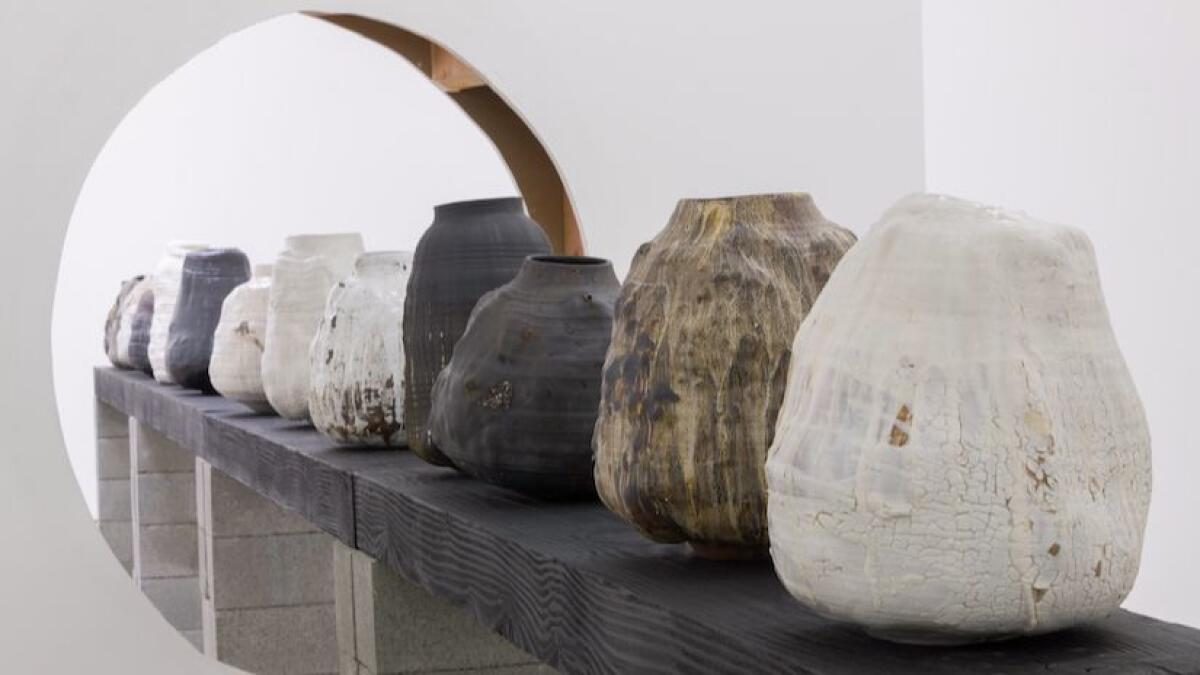
Teodor Graur, “Sample of European Contemporary Art,” at Nicodim. The Romanian artist takes elements of Eastern European culture — bits of signage, old tools, reconfigured furnishings — and recycles them into humorous assemblages that critique the country’s transitional capitalism. Through Jan. 20. 571 S. Anderson St., Ste. 2, Boyle Heights, nicodimgallery.com.
Eduardo Sarabia, “Drifting on a Dream,” at the Mistake Room. The L.A.-born, Guadalajara-based artist is known for a wide-ranging practice that includes fabricating tequila and creating traditional-looking ceramics that riff on popular culture, commerce and politics. The show, which functions as an immersive installation, includes a stage that will be employed for a range of events — including as a set for video that Sarabia is in the process of shooting. Through Jan. 20. 1811 20th St., downtown Los Angeles, tmr.la.
“Memories of Underdevelopment: Art and the Decolonial Turn in Latin America, 1960-85,” at the Museum of Contemporary Art San Diego. A group exhibition organized in collaboration with the Museo Jumex in Mexico City and the Museo de Arte de Lima in Peru focuses on the ways in which Latin American artists have contended with the evaporating promise of Modernism in the 1960s through the 1980s — a period racked by instability and brutal dictatorships — with wildly experimental and politically charged works. The show includes pieces by figures such as Hélio Oticica, Lygia Pape, Eugenio Espinoza and others. This is a PST: LA/LA must-see. Through Jan. 21. 1100 Kettner Blvd., San Diego, mcasd.org.
“Mike Kelley: Kandors 1999-2011,” at Hauser & Wirth. This is the first comprehensive survey of Kelley’s “Kandors” series, which reimagines the fictional city from the Superman comics — the capital of Krypton, which was shrunk and kept in a jar by a supervillain. The show includes the artist’s oversized sculptures that depicted the imagined city, as well as drawings and Lenticular pieces. Through Jan. 21. 901 E. 3rd St., downtown Los Angeles, hauserwirthlosangeles.com.
“There is Only One Paul R. Williams: A Portrait by Janna Ireland,” at WUHO Gallery. Photographer Ireland spent a year getting to know the architecture of Paul R. Williams, a pioneering African American architect whose forms dot L.A. (He had a major hand in designing the iconic space age Theme Building at LAX airport.) The images serve as a study of the late architect’s domestic, public and commercial spaces — key work for a figure who has received important recognition after his death. Through Jan. 21. 6518 Hollywood Blvd., Hollywood, wuho.architecture.woodbury.edu.
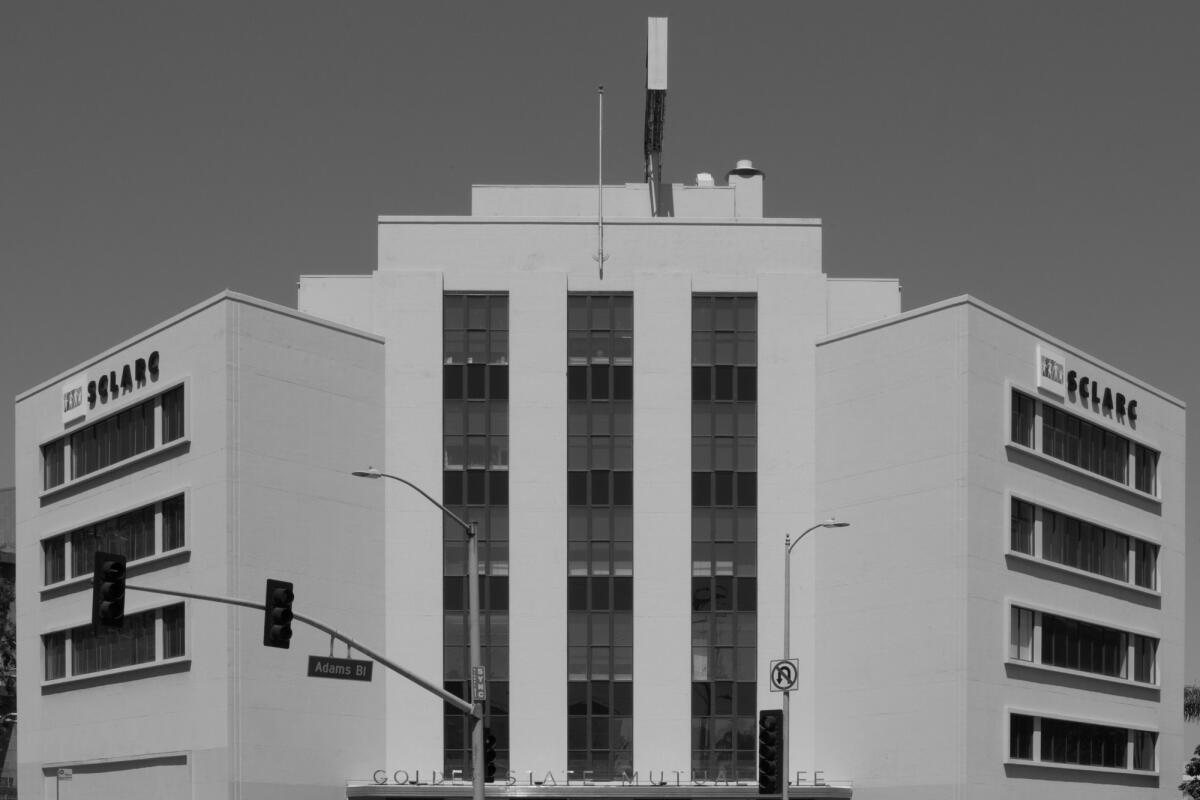
“Below the Underground: Renegade Art and Action in 1990s Mexico” at the Armory Center for the Arts. With Mexico City in the process of recovering from a 7.1 earthquake, it could not be a more timely moment for this exhibition, which looks at the underground movements and artists who helped shape the scene of the ’90s. (A scene, formed in part, by the DIY spirit that arose in response to Mexico City’s devastating 1985 quake.) The show, part of the PST: LA/LA series of exhibitions, includes work by figures such as Eduardo Abaroa, Teresa Margolles and the collective Pinto Mi Raya. Through Jan. 22. 145 N. Raymond Ave., Pasadena, armoryarts.org.
Ruben Ochoa, “Sampled y Surveyed,” at Art + Practice. Over the course of his career, the Oceanside-born artist has long used elements of the urban landscape as his primary material: chain link, concrete, steel and bits of earth. In fact, Ochoa once quite famously jammed a slab of wall and a mound of earth into a room for an installation that looked as if a destabilized portion of freeway had crashed into a white cube. This exhibition at Art + Practice considers Ochoa’s large-scale pieces and the ways in which they employ, manipulate and transform space. Through Jan. 27. 3401 W. 43rd St., Leimert Park, Los Angeles, artandpractice.org.
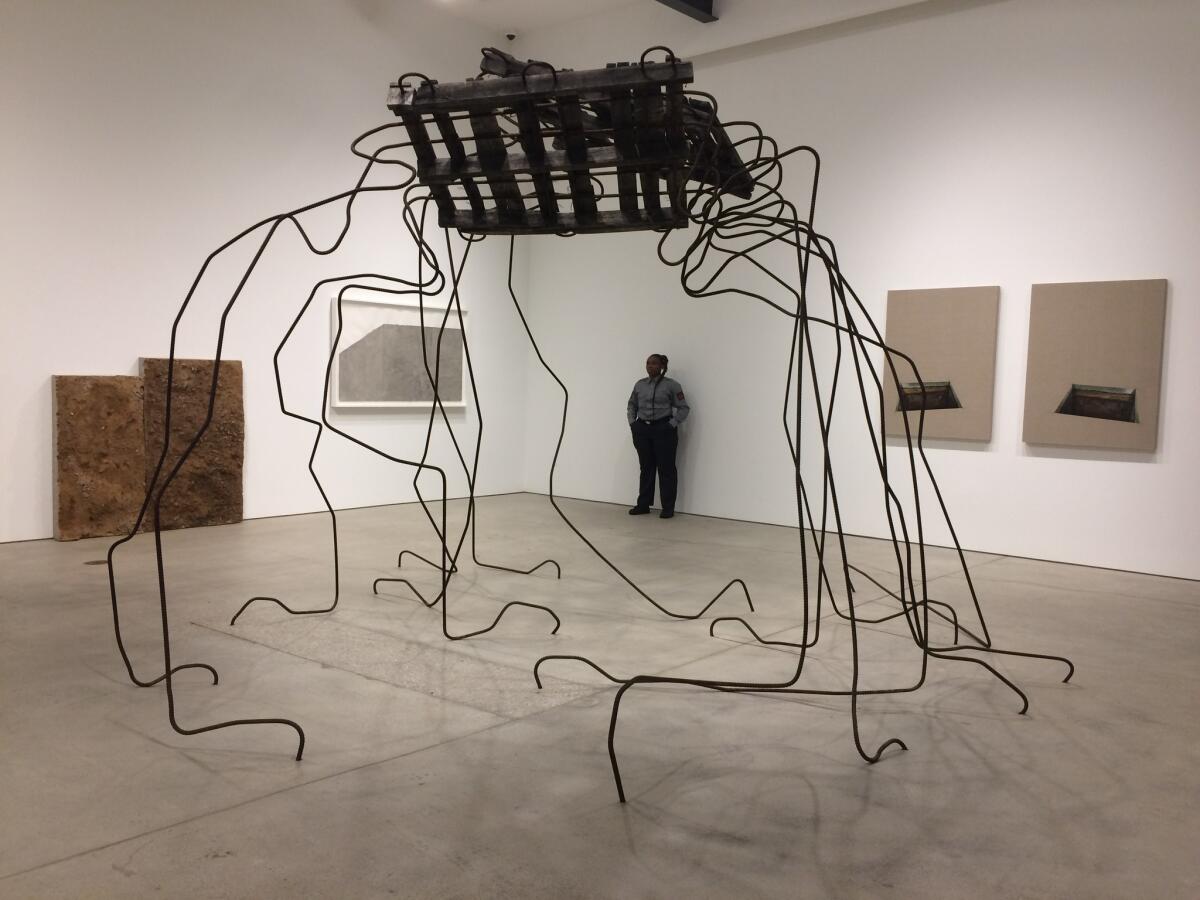
Ellen Gallagher, “Accidental Records,” at Hauser & Wirth. The artist’s first solo exhibition in Los Angeles feature new paintings and drawings that explores the Middle Passage and the idea of creating records of those ocean journeys by creating layered pieces that capture elements of the roiling ocean, the fauna within it and the cultural histories that frame it on either sides of the Atlantic. Through Jan. 28. 901 E. Third St., downtown Los Angeles, hauserwirthlosangeles.com.
“Judithe Hernández and Patssi Valdez: One Path Two Journeys,” at the Millard Sheets Art Center. Two of Los Angeles’ most iconic Latina artists come together for this two-woman show, which features a broad selection of current works as well as a new collaborative installation. Through Jan. 28. 1101 W. McKinley Ave., Pomona, pacificstandardtime.org.
“Golden Kingdoms: Luxury and Legacy in the Ancient Americas,” at the Getty Museum. An international exhibition featuring more than 300 masterpieces from throughout Latin America chronicles the most refined examples of craft and artisanry from about 1000 BC to the arrival of the Europeans. This includes sumptuous works of gold, ceramic, painting and textile from the ancient kingdoms of Peru, Mexico, Guatemala and Colombia. Through Jan. 28. 1200 Getty Center Dr., Brentwood, Los Angeles, getty.edu.
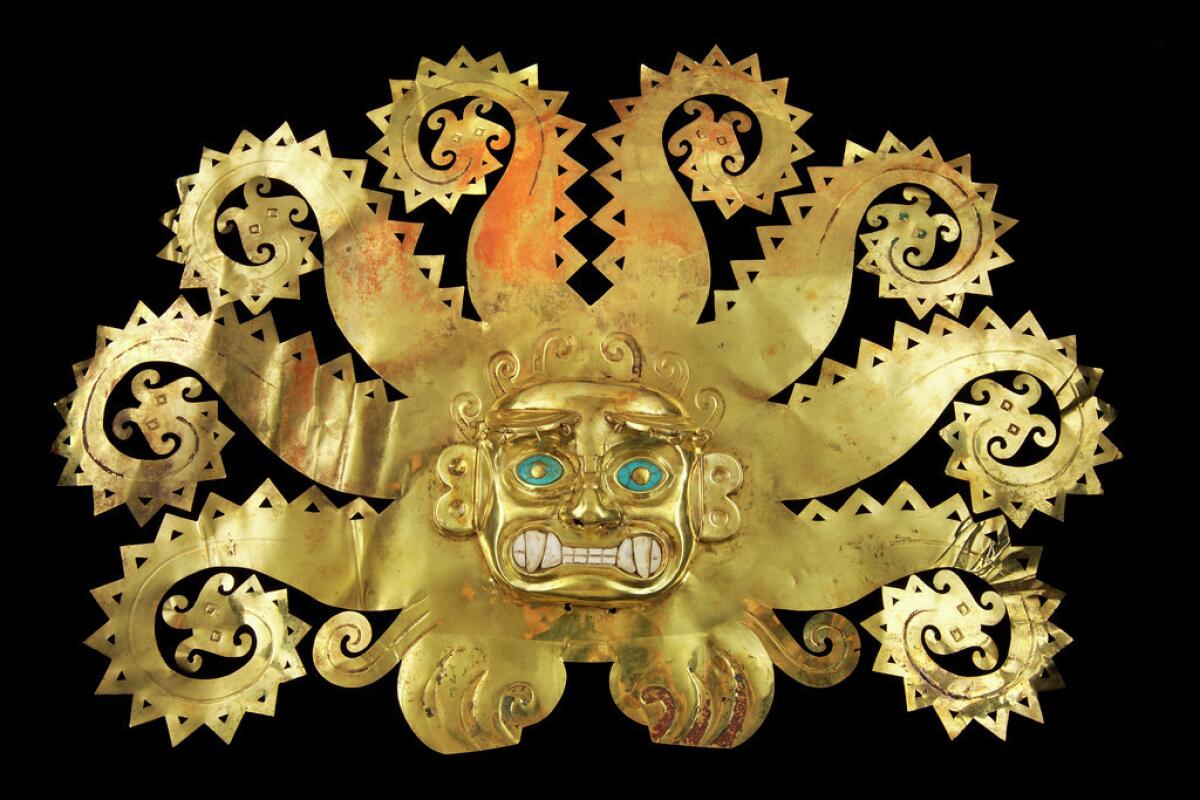
“Condemned to be Modern,” at the Los Angeles Municipal Art Gallery. This exhibition looks at the ways in which Latin American artists have contended with the legacy of Modernist architecture throughout the continent, looking at its innovations, and the ways it has and hasn’t fulfilled its utopic ideals in countries such as Mexico, Cuba and Brazil. Through Jan. 28. 4800 Hollywood Blvd., Hollywood, lamag.org.
Gusmano Cesaretti, “Varrio,” at Little Big Man Gallery. The photographer spent much of the ’70s documenting the life and landscape of the Eastside of Los Angeles: car clubs, children, cholos, and the inhabited and uninhabited bits of this urban environment. The show will include many of his vintage black and white prints, crafted on Japanese paper. Through Feb. 3. 1427 E. Fourth St., Boyle Heights, Los Angeles, littlebigmangallery.com.
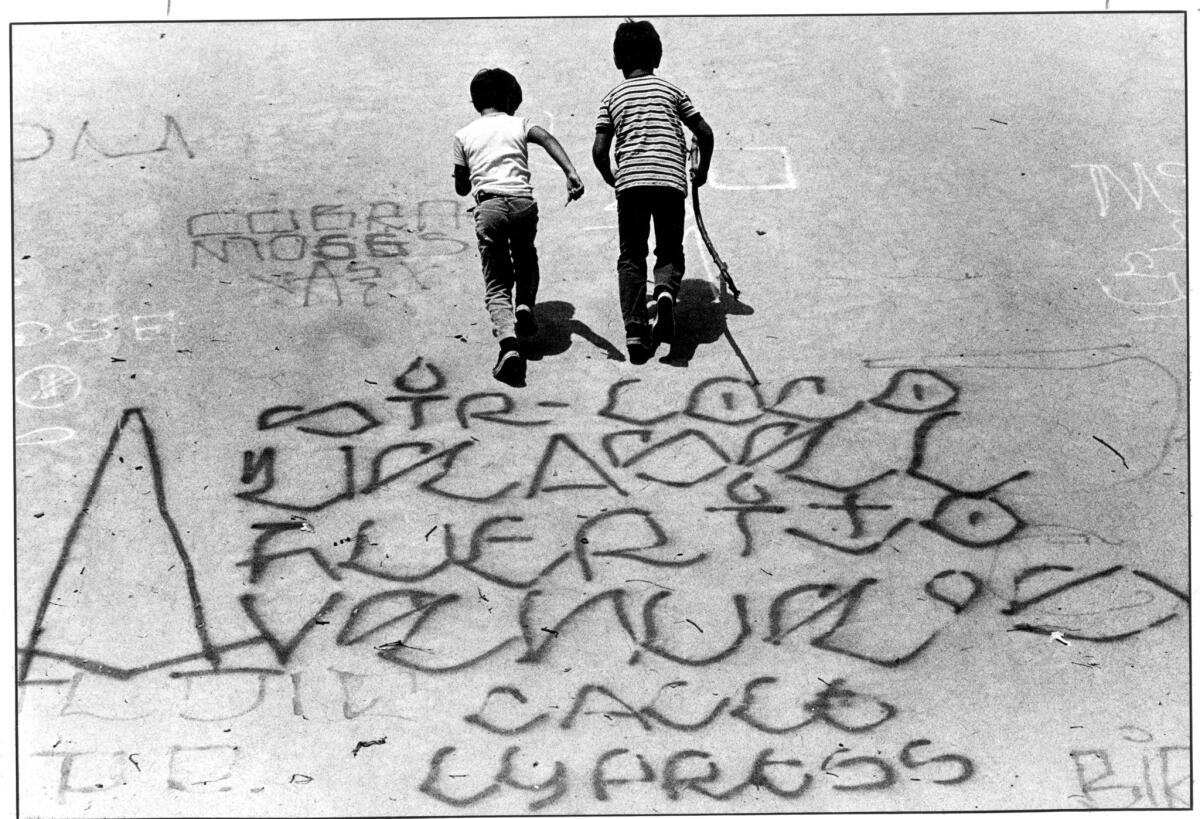
Laura Aguilar, “Show and Tell,” at the Vincent Price Art Museum. This is the first comprehensive retrospective devoted to the Southern California photographer, who chronicled queer life in Los Angeles, and also devoted a good portion of her photographic practice to visceral self-portraits she staged in the wilderness. These play with texture, form, body image and what it means to be a woman. It’s a long-overdue look at a singular L.A. photographer. Through Feb. 10. 1301 Cesar Chavez Ave., Monterey Park, vincentpriceartmuseum.org.
“La Raza,” at the Autry Museum of the American West. In its day, the civil rights publication “La Raza,” which was based in Lincoln Heights, served as a bible for the Chicano movement, covering protest, policy and everyday life for the Mexican American communities of Los Angeles. Over the years, the paper amassed an archive of 25,000 images, recently digitized by the Chicano Studies Research Center. Many are now on view as part of this PST: LA/LA show at the Autry — and in a time of political strife surrounding the issues of civil rights, this exhibition couldn’t be more timely. Also on view is Harry Gamboa Jr.’s photographic series “Chicano Male Unbonded.” Through Feb 10. 4700 Western Heritage Way, Griffith Park, Los Angeles, theautry.org.
“Kukuli Velarde: Plunder Me Baby” at the American Museum of Ceramic Art. The U.S.-based Peruvian artist is known for producing sculpture, inspired by indigenous ceramics, that use ancient symbols to tweak contemporary culture and its prejudices. Through Feb. 11. 399 N. Garey Ave., Pomona, amoca.org.
“Names Printed in Black” at Los Angeles Contemporary Exhibitions. A group exhibition organized by Emily Butts looks at the way in which groups collectively remember issues of violence, politics and the media. This will include works and installations by Carmen Argote, Adriana Corral, Carlos Motta, Lisa C. Soto and Samira Yamin. Through Feb. 11. 6522 Hollywood Blvd., Hollywood, welcometolace.org.
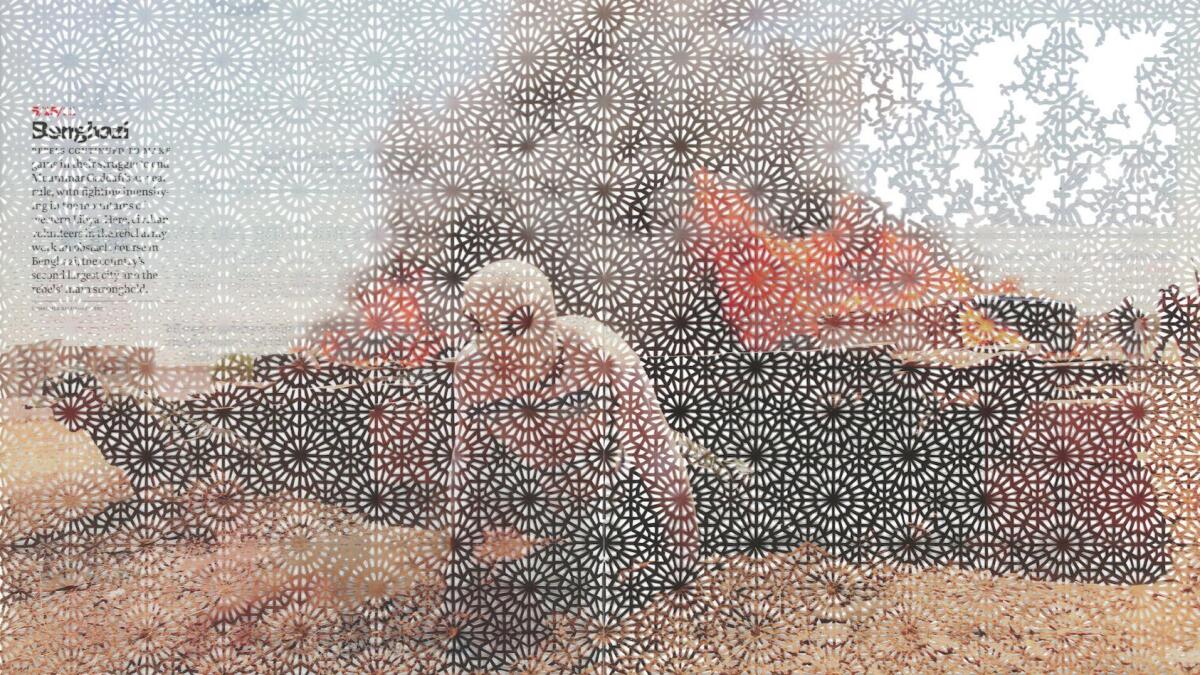
“Finding Form” at the Getty Museum. An exhibition drawn from the museum’s permanent collection looks at the ways in which artists layer color, line and shape to create likenesses of objects, people and landscape. The exhibition gathers works produced over three centuries, from the 1500s to the 1800s. Through Feb. 11, 1200 Getty Center Drive, Brentwood, Los Angeles, getty.edu.
Maya Gurantz, “Deipnophoroi,” at the Grand Central Art Center. This video installation is inspired by an ancient Greek festival documented by the essayist Plutarch, in which a community would reenact a mythical ritual of sending young men to be fed as sacrifice to the Minotaur. As part of it, women were allowed to bring food to comfort their children as they faced terrible death. Gurantz has created a video diptych that reflects on the idea of a mother preparing her child for “the unutterable.” Through Feb. 11. 125 N. Broadway, Santa Ana, grandcentralartcenter.com.
Georganne Deen, “Psychic Violence, in America,” and Matt Lifson, “How is your fever,” at CB1 Gallery. The gallery is kicking off the year with its first solo exhibition devoted to L.A. artist Matt Lifson, a painter whose work draws inspiration from film and photography. Also on view will be an exhibition of paintings by Georganne Deen — her first at the gallery. The artist creates works that fuse society portraits with lowbrow popular culture and critiques of laissez-faire capitalism. Through Feb. 17. 1923 S. Santa Fe Ave., downtown Los Angeles, cb1gallery.com.
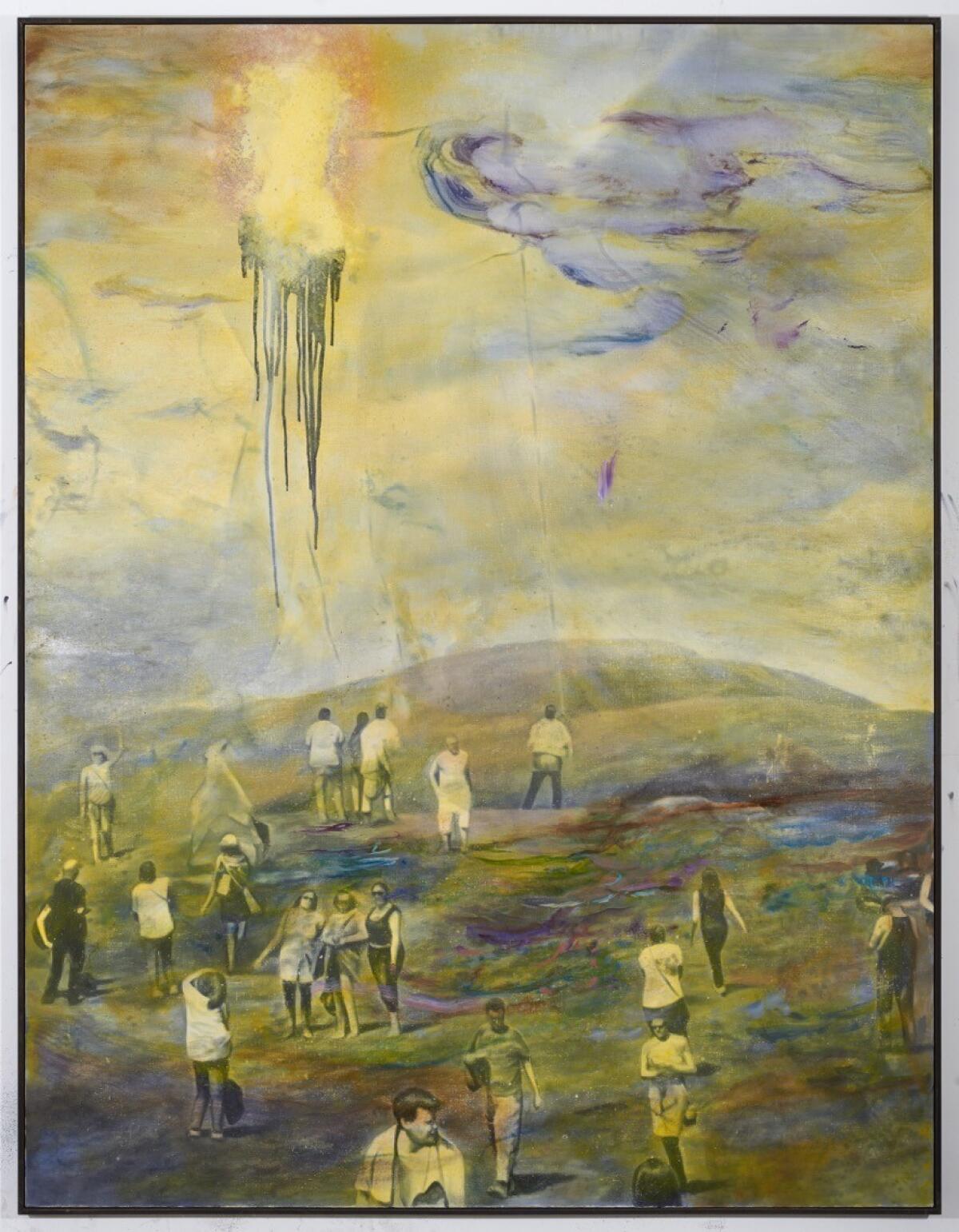
“Standing Rock: Art and Solidarity,” at the Autry. The Standing Rock protest in North Dakota attracted an unprecedented protest that brought together native and non-native cultures in a unified front against the proposed Dakota Access pipeline. This exhibition gathers ephemera from that action, including poster art, clothing and photographs. Through Feb. 18. 4700 Western Heritage Way, Griffith Park, Los Angeles, theautry.org.
“Secret Sister: Jessica Jackson Hutchins and Rebecca Morris,” and “Benjamin Weissman + Ravi Jackson,” at the Pit. The Glendale hot spot is kicking off the new year with a pair of new shows featuring pairs. This includes an exhibition by a pair of artists who are also lifelong friends: ceramicist Jessica Jackson Hutchins and Rebecca Morris, and the pairing of Bejanmin Weissman and Ravi Jackson, which features a site-specific installation inspired by drawing. Through Feb. 18. 918 Ruberta Ave., Glendale, the-pit.la.
Lezley Saar, “Salon des Refusés,” at California African American Museum. Painter Lezley Saar has long explored ideas of marginality and the cosmic in intimate paintings that feature figures both real and invented. Her new solo show at CAAM gathers works from various series exploring the in-between spaces of gender, race and the mind. Of particular note is a large painted textile, which hangs on the wall like a majestic Victorian tapestry, and depicts a woman with albinism — a striking stand-in for the artist, who is part black but looks white. Through Feb. 18. 600 State Drive, Exposition Park, Los Angeles, caamuseum.org.
“Caravaggio: Masterpieces from the Galleria Borghese,” at the Getty Museum. A small gem of a show features six works by the baroque master from the collections of the Galleria Borghese in Rome. This includes canvases of a sensuous boy holding a basket of dewy fruit, the thoughtful St. Jerome lost in sacred study and, most dramatically, his early 17th century canvas of David bearing the head of Goliath. The giant’s surprised-looking face was inspired by the artist’s own features. Consider this a must-see. Through Feb. 18. 1200 Getty Center Dr., Brentwood, Los Angeles, getty.edu.
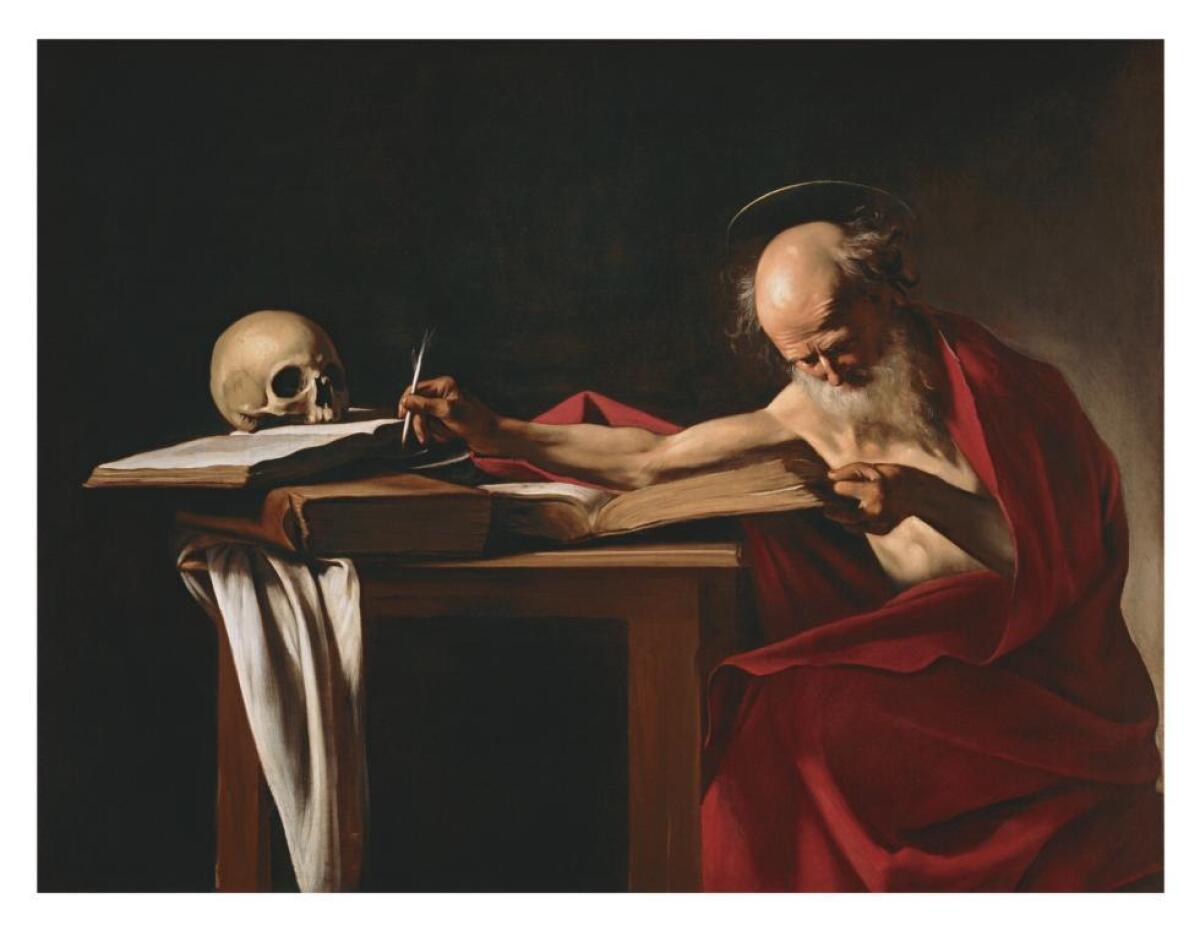
“A Universal History of Infamy,” at the Los Angeles County Museum of Art. The latest in the PST: LA/LA series brings together the work of 16 Latin American and U.S. Latino artists that challenge notions of region. Many of the artists don’t inhabit a single country — often going back and forth between multiple locations, cultures and ideas. The show includes installation and performance by artists such as Brazilian Carla Zaccagnini, who is preoccupied with history; Stefan Benchoam and Jessica Kairé, who manage an egg-shaped mini-museum in Guatemala; and Colombian Angeleno artist Gala Porras-Kim, whose work often explores the ways in which culture is presented and interpreted. The show takes place across three venues, including the BCAM galleries at LACMA, the museum’s exhibition space at Charles White Elementary School near MacArthur Park (opening Dec. 9), and the 18th Street Arts Center in Santa Monica (through Dec. 15), where a number of the show’s artists had residencies. Through Feb. 19. 5905 Wilshire Blvd., Mid-Wilshire, Los Angeles, lacma.org.
“Día de los Muertos: A Cultural Legacy, Past, Present & Future,” at Self Help Graphics & Art. A historic exhibition looks back at the celebrations for Day of the Dead organized by the community arts nonprofit since 1972. This includes photography, historical prints and three specially commissioned altars from Ofelia Esparza, Marcus Kuiland-Nazario and Gerardo Yépiz (otherwise known as Acamonchi). Through Feb. 24. 1300 E. First St., Boyle Heights, Los Angeles, selfhelpgraphics.com.
Robb Putnam, “Interlopers,” at Walter Maciel Gallery. Putnam takes materials such as old parachutes, drop cloths, Army blankets and duffel bags and uses them to create an artistic collection of bear-like creatures that he suspends on the gallery walls. Through Feb. 24. 2642 S. La Cienega Blvd., Culver City, waltermacielgallery.com.
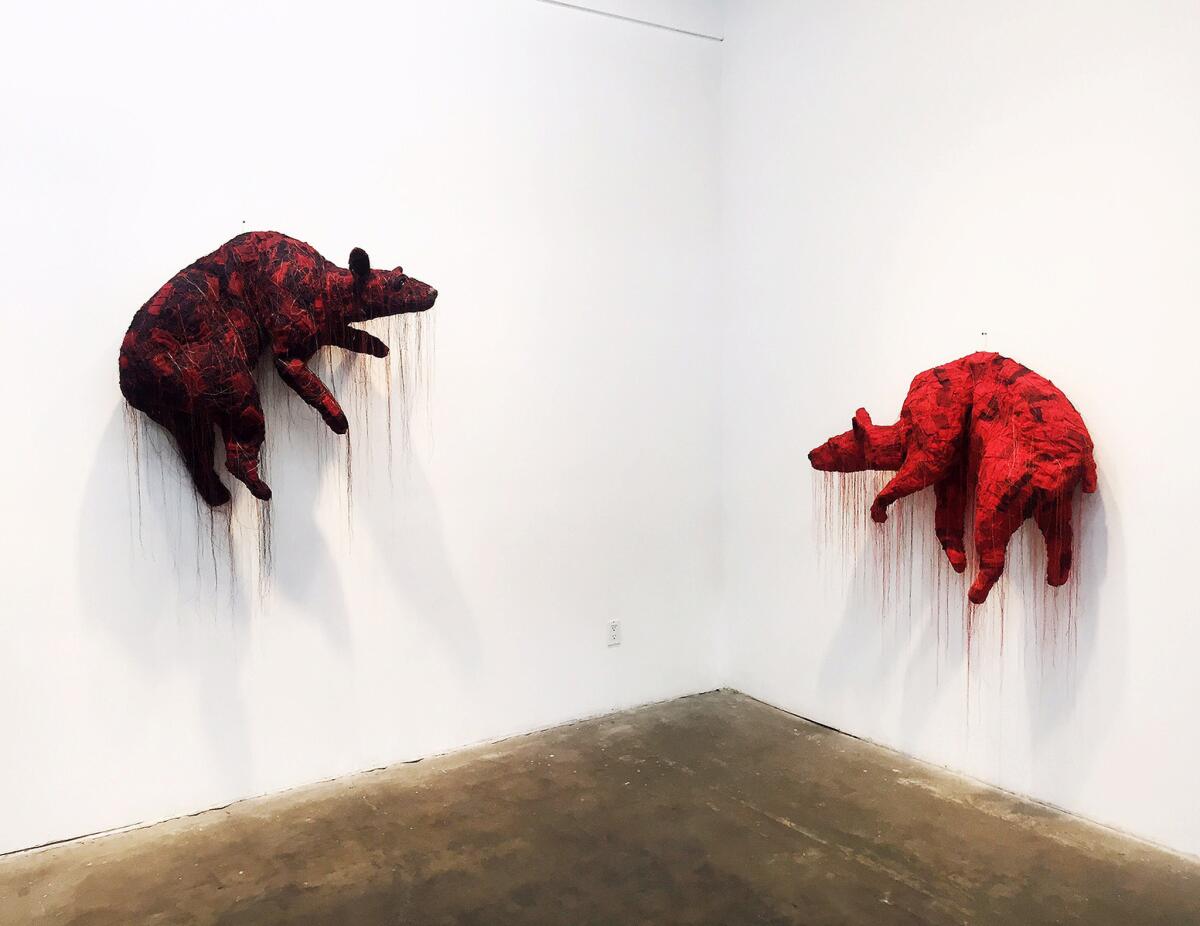
Ken Gonzales-Day, “Surface Tension: Murals, Signs, and Mark-Making in L.A.,” at the Skirball Cultural Center. This is a new series from the artist known for conceptual photo projects that have chronicled old hanging trees and reimagined scenes of protest. For this PST: LA/LA exhibition he turns his attention to murals and the ways in which they inhabit L.A.’s urban landscape. Through Feb. 25. 2701 N. Sepulveda Blvd., Brentwood, skirball.org.
“Transpacific Borderlands: The Art of Japanese Diaspora in Lima, Los Angeles, Mexico City and Sao Paulo,” at the Japanese American National Museum. This exhibition also examines the intricate nature of Latin American identity — which, in many nations, bears a distinctly Japanese stamp. Expect work by artists of Japanese heritage working throughout the continent, whose art explores issues of homeland, race and cosmopolitanism. Through Feb. 25. 100 N. Central Ave., Los Angeles, janm.org.
“Relational Undercurrents: Contemporary Art of the Caribbean Archipelago,” at the Museum of Latin American Art. Curated by Caribbean art scholar Tatiana Flores, this major survey of 21st century Caribbean art gathers a wide range of work — performance, photography, painting — by more than 80 artists with roots in the region. Organized by theme rather than region, the show looks at subjects common to the diverse populations of the Caribbean: colonialism, race and ethnicity, questions of history and identity, sovereignty, migration and sustainability. Through Feb. 25. 628 Alamitos Ave., Long Beach, molaa.org.
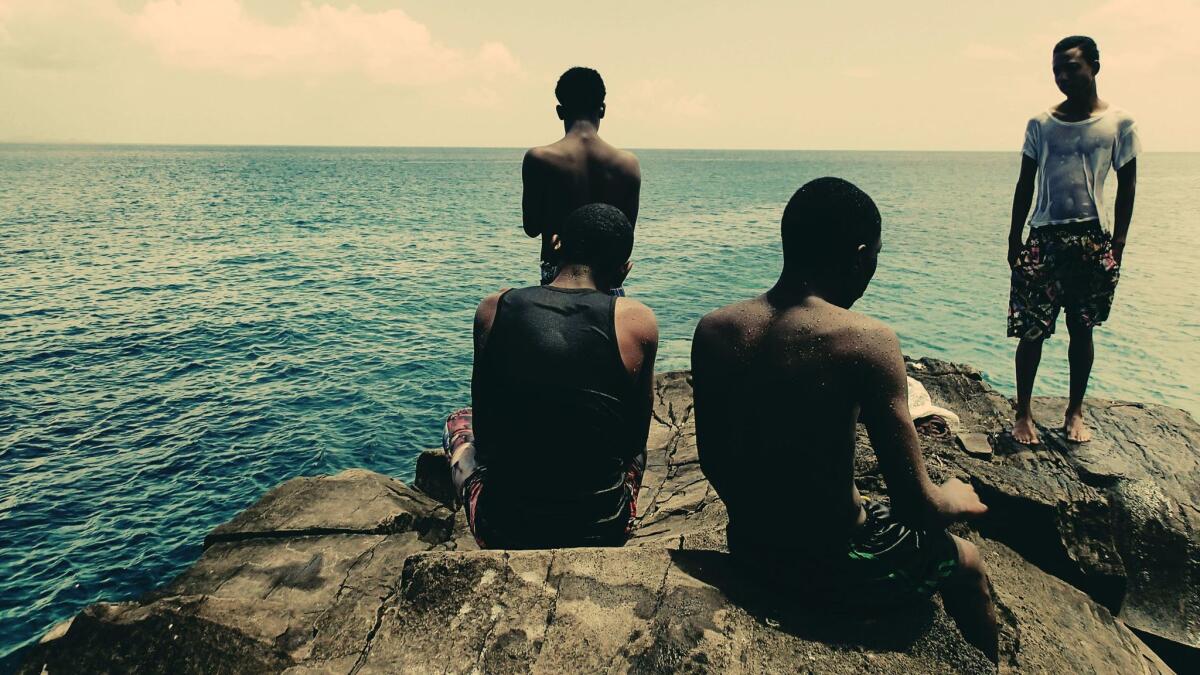
“Another Promised Land: Anita Brenner’s Mexico,” at the Skirball Cultural Center. Brenner was an American Jewish writer who was associated with an important cohort of 1920s Mexican modernists and was key to presenting Mexican art to audiences in the United States. The writer was close with figures such as José Clemente Orozco, Frida Kahlo, Diego Rivera and Tina Modotti — and some of their art is featured in the show, along with Brenner’s personal effects. Through Feb. 25. 2701 N. Sepulveda Blvd., Brentwood, Los Angeles, skirball.org.
Hugo Crosthwaite, “In Memoriam Los Angeles,” at the Los Angeles Methodist Museum of Social Justice. The noted Tijuana painter, known for phantasmagoric black and white murals that seamlessly fuse slices of urban life with the slightly deranged and fantastical, is creating an improvisational mural that is inspired by his observations of people in downtown Los Angeles. The mural is to be painted only during the opening hours, during which time the public is invited to drop in and observe. After completing the work, Crosthwaite will then proceed to obliterate the piece by painting it out bit by bit. Through Feb. 25. La Plaza United Methodist Church, 115 Paseo de la Plaza, Los Angeles, museumofsocialjustice.org.
“The Reformation: From the Word to the World,” at the Huntington. It is the 500th anniversary of the Protestant Reformation and this is the second Los Angeles exhibition to explore the legacy of that momentous religious and social shift. (The first was at the Los Angeles County Museum of Art last year.) Drawn primarily from the holdings of the Huntington’s collections, it features 50 rare books and manuscripts, as well as prints made between the 1400s and 1648 (the end of the Thirty Years War). Expect to see treasures by Albrecht Dürer as well as a real-deal papal indulgence signed by Pope Leo X in 1515 — a.k.a. the sorts of things you learned about in school. Through Feb. 26. 1151 Oxford Road, San Marino, huntington.org.
“To Protect & Serve: Posters Protesting 50 Years of Police Violence,” by the Center for the Study of Political Graphics” at the Durón Gallery at SPARC. A bilingual exhibition organized by the Center for the Study of Political Graphics brings together 75 posters that deal with the issue of police violence in cities across the U.S., as well as in Mexico, Chile, Europe and Africa. Through March 2. 685 Venice Blvd., sparcinla.org and politicalgraphics.org.
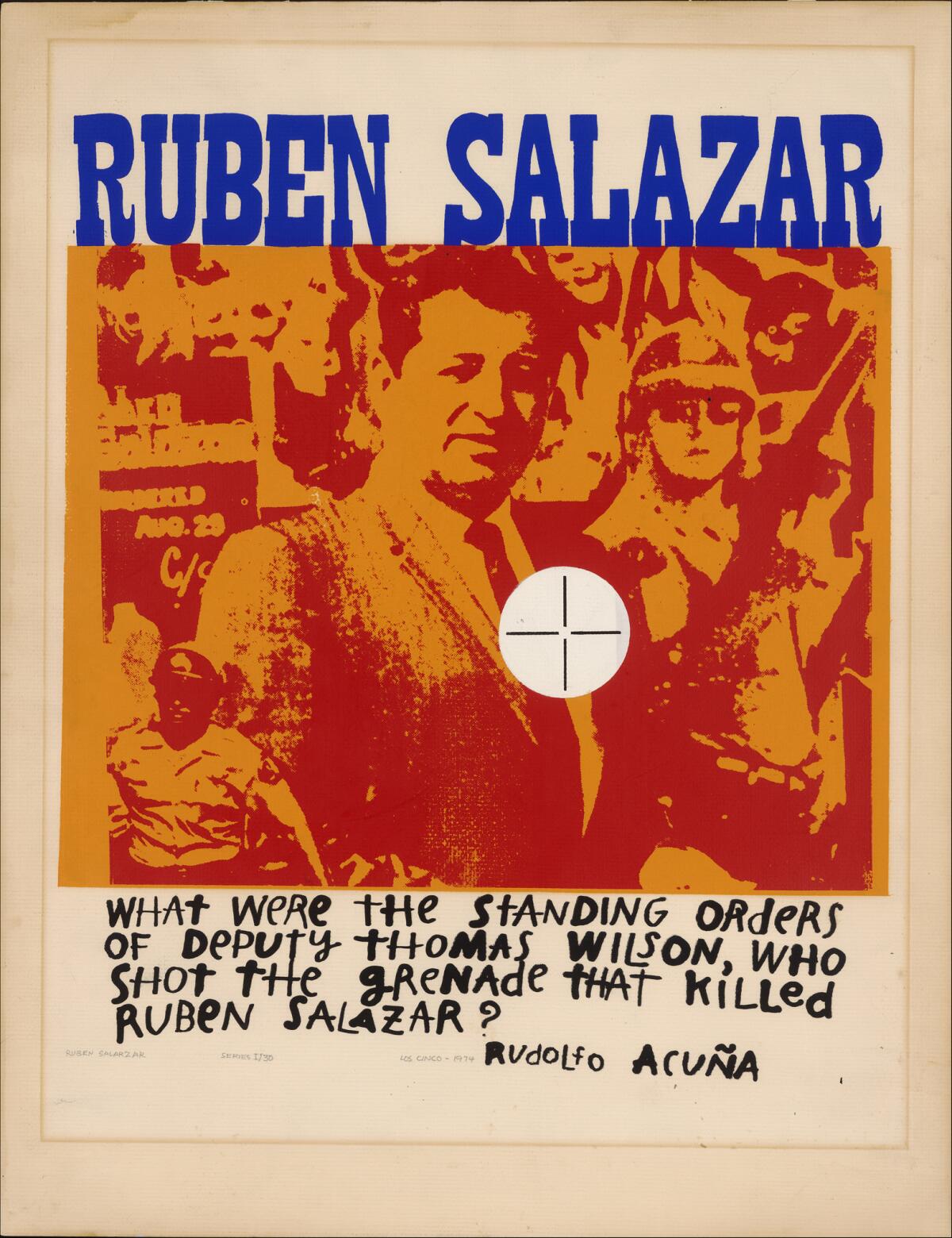
“Circles and Circuits: Chinese Caribbean Art,” at the Chinese American Museum and the California African American Museum. Latin American identity is often identified with the concept of the mestizo, the hybrid indigenous-Spanish culture that has predominated in large parts of Latin America. But the Asian contribution has been key to the development of culture, food and industry. This two-part exhibition looks at the Chinese presence in countries on the Caribbean Sea, including Jamaica, Cuba, Panama and Trinidad and Tobago. At CAAM through Feb. 25. 600 State Dr., Exposition Park, Los Angeles, caamuseum.org. At the Chinese American Museum through March 11. 425 N. Los Angeles St., downtown Los Angeles, camla.org.
“¡Murales Rebeldes! L.A. Chicana/o Murals Under Siege,” at La Plaza. A historical exhibition looks at a history of Chicano muralism in Southern California through the works that have been censored and destroyed. This includes documentation of important works by iconic SoCal muralists such as Barbara Carrasco, Yreina D. Cervántez, Willie Herrón III (of Asco fame), Roberto Chavez and the collective known as the East Los Streetscapers (David Botello, Wayne Alaniz Healy and George Yepes). Through Feb. 27. 501 N. Main St., downtown Los Angeles, lapca.org.
“Rembrandt: Prints ‘of a Particular Spirit,’” at the Norton Simon Museum. The Dutch Golden Age painter is widely renowned for his deeply human portraits. But he was also a masterful printer. And this exhibition brings together elements of his graphic work from the 1630s, the period in which he became a sought-after portraitist. This includes stirring genre scenes as well as humorous self-portraits — such as an image in which the artist depicts himself as a vagrant. In conjunction with the show, the museum will be displaying Rembrandt’s celebrated “Self Portrait at the Age of 34,” on loan from the National Gallery in London. Through March 5. 411 W. Colorado Blvd., Pasadena, nortonsimon.org.
Kota Ezawa, “The Crime of Art (Hollywood Edition),” at Christopher Grimes Gallery. The exhibition centers on a new multi-channel animated film titled “The Crime of Art,” in which Ezawa re-creates scenes from famous art heist films, including “The Thomas Crown Affair” and “How to Steal a Million.” Also on view will be light-box works inspired by stolen works of art, such as Edvard Munch’s “The Scream” and Gustav Klimt’s “Portrait of Adele Bloch-Bauer.” Through March 10. 916 Colorado Ave., Santa Monica, cgrimes.com.
“Painted in Mexico, 1700-1790: Pinxit Mexici,” at the Los Angeles County Museum of Art. This groundbreaking exhibition gathers more than 100 paintings created in Mexico over the course of the 18th century — many on view for the first time. The exhibition, organized by LACMA and the Fomento Cultural Banamex in Mexico City, and part of PST: LA/LA, looks at the paths that Mexican painting was taking in the third century after colonization — influenced by transatlantic trade, but also developing a voice of its own. The period saw a rise in the creation of mural-size works to decorate churches, as well as a boon in the region’s singular casta paintings, which documented the racial types of the booming colony. The works range from the pastoral to the wondrously bizarre. Don’t miss the puzzling allegorical canvas that shows the continent of America in the company of ancient rulers Moctezuma and Atahualpa. Through March 18. 5905 Wilshire Blvd., Mid-Wilshire, Los Angeles, lacma.org.
“Found in Translation: Design in California and Mexico,” at the Los Angeles County Museum of Art. A groundbreaking design exhibition looks at the points of connection in design — architectural, fashion, graphic and other — between California and Mexico between 1915 and 1985. It’s a thorough examination of how designers in the two locales combined local materials with an interest in pre-Columbian and colonial design, as well as folk and craft traditions, to create singular approaches to Modernism that also overlapped in countless ways. The exhibition includes a diverse range of objects, including dresses, political posters, architectural drawings, furnishings and a show-stopping late 19th century piano carved in a pre-Columbian style. Wowza! Through April 1. 5905 Wilshire Blvd., Mid-Wilshire, Los Angeles, lacma.org.
“Patrick Martinez: America is for Dreamers,” at the Vincent Price Art Museum. This is the artist’s first solo museum exhibition in Los Angeles, a figure whose work examines the city’s landscape (such as stucco walls, commercial neon, street signage) as much as the social forces that shape it (inequity and police violence). The show’s title toys with notions of the American dream, as well as the uncertain status of recipients of Deferred Action for Childhood Arrivals (known as DACA), the federal program that allows illegal immigrants brought to the U.S. as children to remain in the country. Through April 7. East Los Angeles College, 1301 Cesar Chavez Ave., Monterey Park, vincentpriceartmuseum.org.
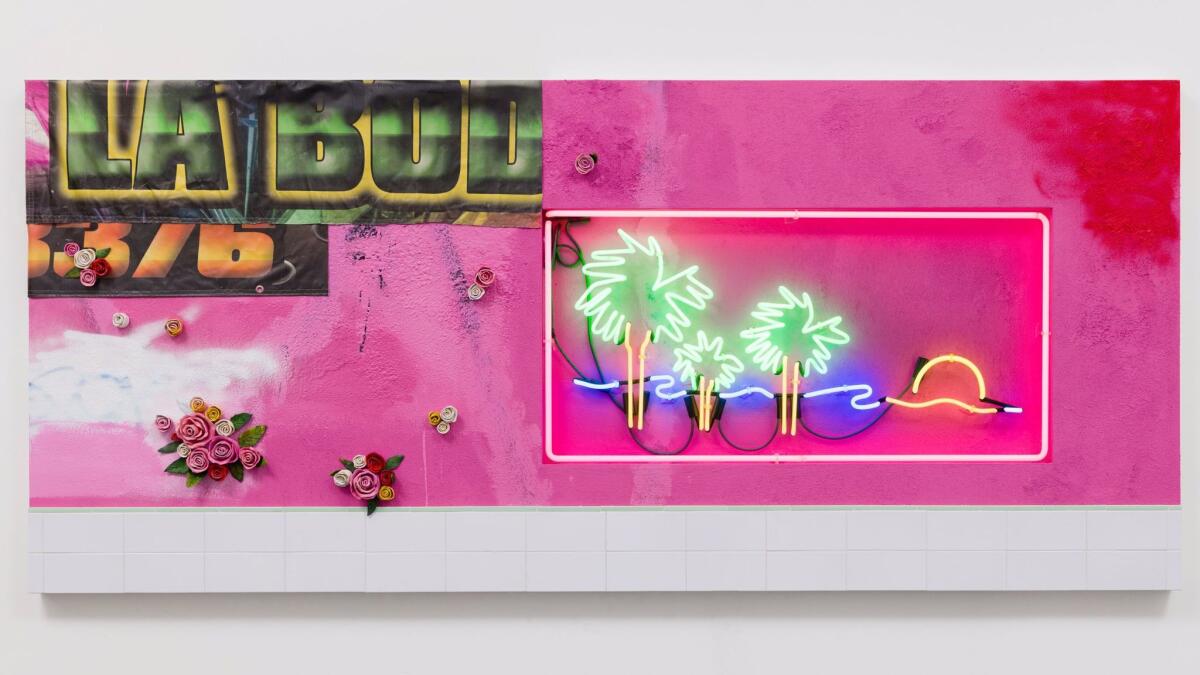
“Liquid Love,” at Gas. Parked outside of the Pit gallery in Glendale will be this ambulatory gallery space featuring a group show that explores desire, love and affection — and the ways in which technology intersects with these needs. Artists included in the show will include Cara Benedetto, Kathy Cho and Angelo Washko. Through April 14. 918 Ruberta Ave., Glendale, gas.gallery.
“Axé Bahia: The Power of Art in an Afro-Brazilian Metropolis,” at the Fowler Museum. Brazilian art has been well-represented throughout the Pacific Standard Time exhibitions around the region. This show looks specifically at what has been happening artistically in Bahia since the 1940s, the city that represents the heart of Afro-Brazilian culture. This includes works by key Modernists, including Mário Cravo Neto and Rubem Valentim, as well as contemporary figures such as as Caetano Dias and Ayrson Heráclito — all represented in more than 100 works of sculpture, painting, photography, video and installation. Through April 15. UCLA, 308 Charles E. Young Drive North, Westwood, Los Angeles, fowler.ucla.edu.
“Cold War Spaces,” “The Russians” and “Vessel of Change” at the Wende Museum. The museum, an underrated Los Angeles gem preserving the art and history of the Cold War, is celebrating a move to new digs at the National Guard Armory in Culver City. The grand reopening is marked by the debut of three new exhibitions: “Cold War Spaces” looks at the design of public and private environments, borders and the objects sent into outer space by the U.S. and the former U.S.S.R. “The Russians” is based on a 1970s photo project by Nathaniel Farb that documented a diverse array of ordinary Russians, while “Vessel of Change” is a playful video piece by Bill Ferehawk and David Hartwell that reinterprets the historic Malta Summit between George H.W. Bush and Mikhail Gorbachev in 1989. Through April 29. 10808 Culver Blvd. Culver City, wendemuseum.org.
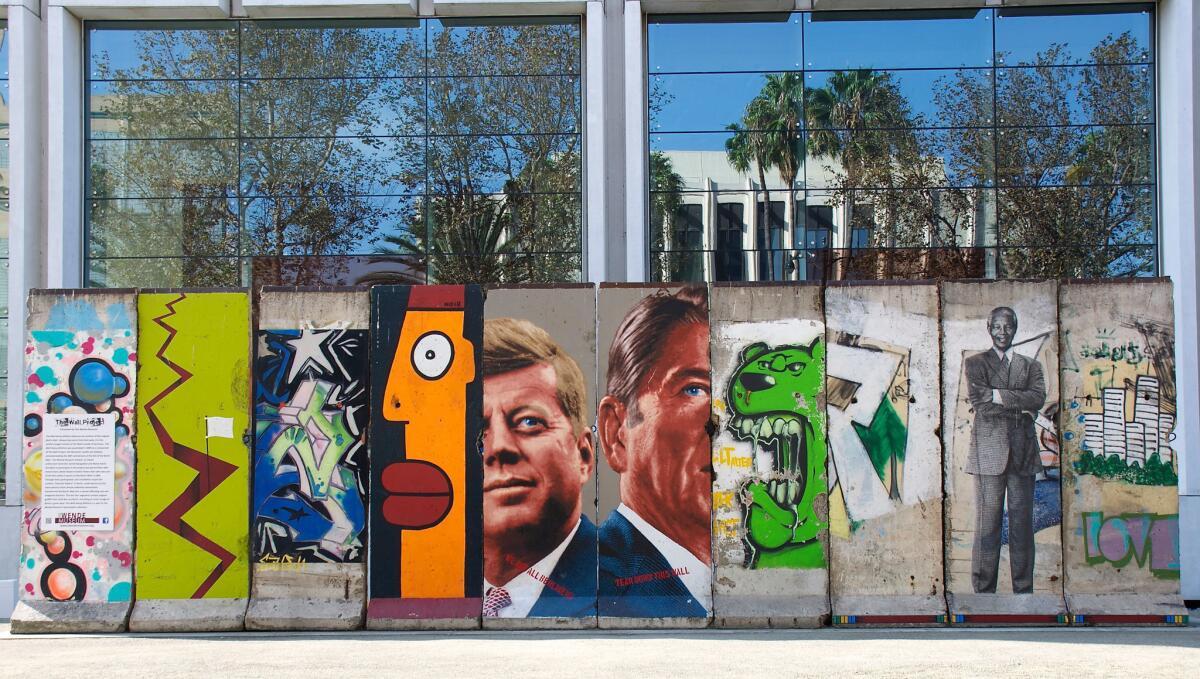
“Hammer Projects: Sam Falls” at the Hammer Museum. For the Hammer’s latest lobby project, the L.A.-based artist traveled to all 19 National Forests in California. In these journeys, he gathered samples of the state’s vegetation, including Ponderosa pine trees and California buckwheat. He then dusted the samples with pigment, employing them as stencils of sorts, to create silhouettes of important state flora. Through April 29. 10899 Wilshire Blvd., Westwood, Los Angeles, hammer.ucla.edu.
John Ford, Samuel Fuller, George Stevens, “Filming the Camps: From Hollywood to Nuremberg,” at the Los Angeles Museum of the Holocaust. Organized by the Mémorial de la Shoah in Paris, this exhibition looks at the vital work done by three key American filmmakers during World War II. Ford, Fuller and Stevens, in the employ of the U.S. Armed Forces and the Secret Services, filmed key aspects of the war — including the liberation of the Nazi concentration camps. The show includes film footage, personal letters, important ephemera and other rare objects and reflects on the way in which playing witness to Nazi atrocities shaped the worldview of these important directors. There could not be a more timely moment for this exhibition. Through April 30. 100 S. Grove Dr., Fairfax District, Los Angeles, lamoth.org.
Jose Dávila, “Sense of Place,” at West Hollywood Park. Visitors can expect to find a six-ton concrete sculpture by the Guadalajara-based artist that will be dispersed in pieces to sites around Los Angeles, where the blocks will take on a life of their own. Next, the pieces will be reunited back into their six-ton block, bearing traces of the neighborhoods they have occupied. Through May. 647 N. San Vicente Blvd., Westwood, nomadicdivision.org.
“Robert Polidori: 20 Photographs of the Getty Museum, 1997” at the Getty Museum. The Getty has turned 20 (it can almost drink!), and to mark the occasion the museum is showing a portfolio of works created by Polidori prior to the museum’s opening in ’97. The photos, on view for the first time, caught the galleries in transition: art wrapped in crates, sculptures off pedestals, bits of packing material in decorative rooms. Through May 6. 1200 Getty Center Drive, Brentwood, Los Angeles, getty.edu.
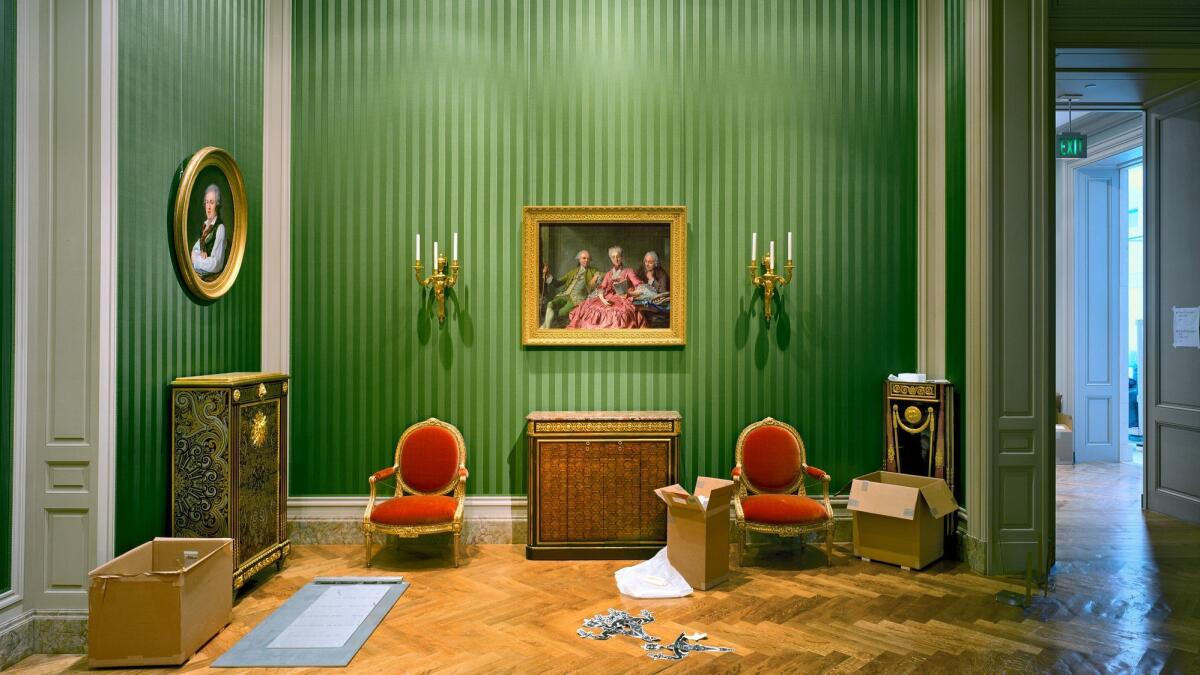
Adrián Villar Rojas, “The Theater of Disappearance,” at the Museum of Contemporary Art. The Argentine-born artist, known for installations that transform spaces — and often play on themes of the apocalyptic — is taking over MOCA’s Little Tokyo space with an installation that employs the architecture and technologies of Hollywood special effects to create an environment that responds to a “post-human world dominated by technology.” Through May 13. Geffen Contemporary, 152 N. Central Ave., downtown Los Angeles, moca.org.
“Winds from Fusang: Mexico and China in the Twentieth Century,” at the USC Pacific Asia Museum. This is the first major exhibition to look at a key trans-Pacific cross-pollination: the influence of Mexican art on the development of art in China in the 20th century. This includes an examination of the period in the 1930s that Mexican artist Miguel Covarrubias spent in Shanghai, and a look at a subsequent era, from the 1950s to the ’70s, when works by key Mexican artists were presented in China. The show, part of PST: LA/LA, is a grand reopening for the museum following a seismic retrofit. Through June 10. 46 N. Los Robles Ave., Pasadena, pacificasiamuseum.usc.edu.
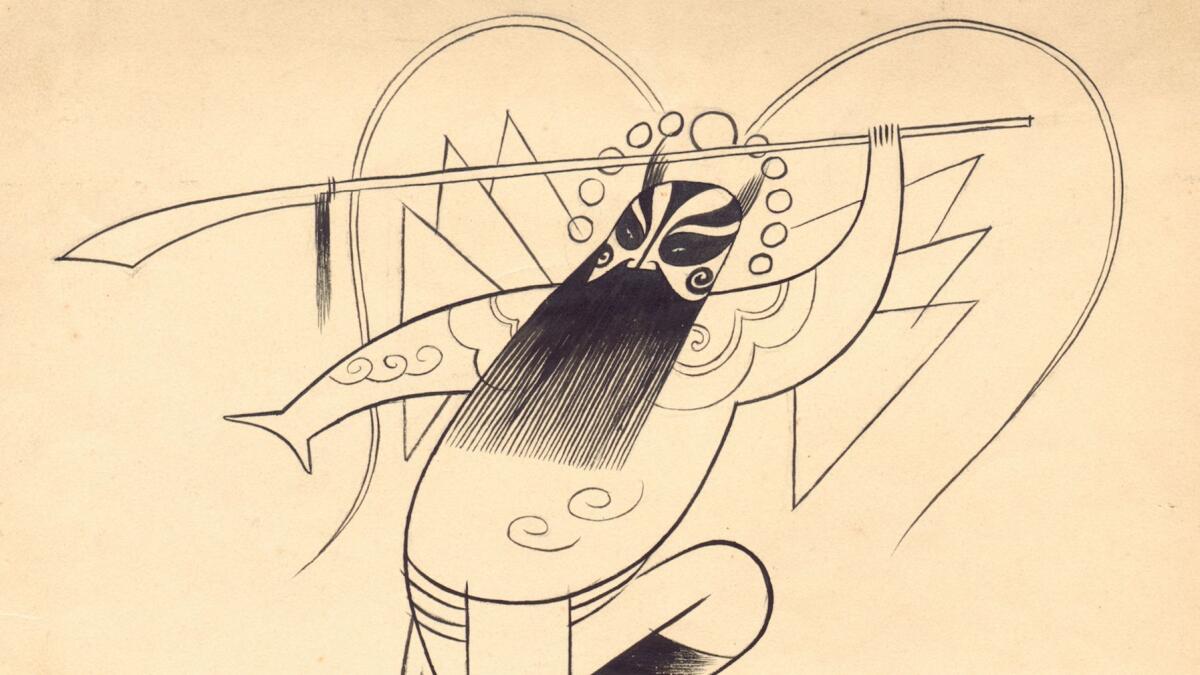
“Gary Simmons: Fade to Black,” at the California African American Museum. In a lobby installation — one that takes full advantage of its size and scale — Simmons pays tribute to forgotten African American actors and films. On a black background, the L.A. artist features the titles and names of films and individuals important to the early days of Hollywood history, but forgotten over time. Through July 2018. 600 State Drive, Exposition Park, Los Angeles, caamuseum.org.
“Artists of Color,” at the Underground Museum. As part of its ongoing partnership with the Museum of Contemporary Art, the Arlington Heights arts space has put together an exhibition that focuses on color — on its aesthetics, as well as the roles color can play as a symbol, affecting the way it’s perceived both socially and politically. The show includes works by an array of artists, including Ellsworth Kelly, Dan Flavin, Lita Albuquerque, EJ Hill, Felix Gonzalez-Torres, Josef Albers, Carmen Herrera and Noah Davis (the late founder of the Underground Museum). It’s a striking look at color seen anew. On long-term view; no closing date set. 3508 W. Washington Blvd., Arlington Heights, theunderground-museum.org.
“L.A. Communities Through the Eyes of Artists,” in the Passageway Gallery at Union Station. For 15 years, L.A.’s principal train station has been showcasing work that reveals the city through the eyes of its artists. This year, it is showing a series of newly commissioned pieces — including Shizu Saldamando’s depiction of Little Tokyo, Sam Pace on Leimert Park and Artemio Rodriguez on East L.A. On long-term view; no closing date set. Union Station, 800 N. Alameda St., downtown Los Angeles, metro.net.
Alejandro G. Iñárritu, “Carne y Arena,” at LACMA. The gripping new virtual reality experience by the Academy Award-winning director places the participant in the shoes of migrants making the arduous trek through the Sonoran desert to reach the United States. This may sound like the trivialization of what can be a fatal journey, but it is not. Iñárritu has considered all of the elements that surround his virtual reality video to humanize the story of immigration on the U.S.-Mexico border. I wrote about my experience of the piece in June. It’s not cheap (it’s a $30 special admission, in addition to regular museum fees) but it’s worth every penny. On long-term view; no closing date set. 5905 Wilshire Blvd., Mid-Wilshire, Los Angeles, lacma.org.
“Pow! Wow!” in Long Beach. The public mural series held in Long Beach every year is back with a series of nearly two dozen new murals in locations around the city, including parking garages and underpasses. Murals will be on long-term view in locations around Long Beach, powwowlongbeach.com.
Daniel Hawkins, “Desert Lighthouse.” The Los Angeles-based artist is obsessed with producing works that toy with ideas of grandiosity, failure and gestures that border on the Sisyphean. (One of his goals as an artist is to ultimately build a scale replica of Hoover Dam.) Now Hawkins has installed a 50-foot tall, fully functioning lighthouse in the Mojave Desert in the vicinity of Barstow. The piece even features a light to guide travelers through this rugged landscape. Directions and coordinates can be found on the website. On long-term view, Hinkley, Calif., desertlighthouse.org.
Sign up for our weekly Essential Arts & Culture newsletter »
Twitter: @cmonstah
The biggest entertainment stories
Get our big stories about Hollywood, film, television, music, arts, culture and more right in your inbox as soon as they publish.
You may occasionally receive promotional content from the Los Angeles Times.








